Waterfront Park Cultural Master Plan
A vision for reflecting and shaping Seattle
 PHOTO: ERIK HOLSATHER, WATERFRONT BLOCK PARTY, 2023
PHOTO: ERIK HOLSATHER, WATERFRONT BLOCK PARTY, 2023
With respect and humility, we acknowledge the history of the waterfront, the dispossession of land from the Coast Salish people and, most importantly, the strength and resilience of the Native people and their culture through this history to the present. This acknowledgement serves only as a first step in honoring the land that we occupy and the first peoples of this land. Friends recognizes that this will be long and
Table of Contents Letter from the CEO 4 Introduction & Executive Summary 8 Belonging 10 Land Stewardship 18 Healing & Sustenance 27 Living Culturally 36 Neighborhood Reciprocity 45 Appendix: Community Co-Design 54 Waterfront
Salish
thrive.
Land Acknowledgment
Park is situated on the land of the Coast
Peoples, who have resided here since time immemorial and continue to
evolving work to build and repair relationships with Native communities.
Sounds of the Park
Waterfront Park has already hosted many wonderful musicians and bands. As you read this document, you can listen along to some of them.


Friends of Waterfront Park Cultural Master Plan 3
3
PHOTO: ADAM LU, PIER SOUNDS, 2023
A Collective Dream
A letter from Joy Shigaki, President and CEO
After over two decades of imagining, planning, and building, Waterfront Park will open to the public in early 2025. Residents and visitors alike will be able to experience this world-class 20-acre park built on shoreline reclaimed from a former highway, reconnecting the city to the water. Overflowing with natural beauty, public art, and stunning views, Waterfront Park will be a place unlike any other in Seattle.
While the city has been building this monumental new public space, Friends of Waterfront Park has played and continues to play an indispensable role, offering non-profit leadership in its management, programming and activation, and sustaining the park now, and for generations to come. Our vision is a Waterfront Park that is as vibrant and rich in community as it is in natural beauty; a place where everyone who visits feels safe, welcome, and at home.
With the Park’s grand opening clear on the horizon, I am excited to share with you our Cultural Master Plan. The Cultural Master Plan is our commitment to honor the stories and histories of our Black, Indigenous, and People of Color communities and continue to center these communities in all aspects of our work. What Waterfront Park can become is laid out in this plan – a collective dream by the growing community of people who see the endless potential of this new place.
While this plan’s origins were to initially support programming at Waterfront

Friends of Waterfront Park Cultural Master Plan 4
PHOTO: JOSHUA LEWIS, JOY SHIGAKI ON PIER 62

Park, we aspire for the Cultural Master Plan to be a living, breathing tool used in our work across the organization. It will serve as a frame of reference, ensuring that our efforts are rooted in the principles of inclusivity, authenticity, and sustainability; and serve as a roadmap charting our course as we navigate the complexities and opportunities of stewardship, programming, and activation at Waterfront Park.
Waterfront Park will be a place of healing. We acknowledge that the downtown shoreline has been the setting to some of our city’s history of violence and exclusion, as well as hopeful stories of solidarity, resilience, and joy. We are deeply appreciative to all of the 148 community members who gathered with us to contribute their perspectives, stories, and hopes during the process of co-creating this plan. Together, we are creating a new civic space that reflects the rich tapestry of our city and serves as a place of joy, hope, healing, and inspiration for generations to come.
Our vision is a Waterfront Park that is as vibrant and rich in community as it is in natural beauty
What an extraordinary place this will be for our city and region. We’re excited about the journey ahead!
With gratitude,
 Joy Shigaki President and CEO Friends of Waterfront Seattle
Joy Shigaki President and CEO Friends of Waterfront Seattle
Friends of Waterfront Park Cultural Master Plan 5
PHOTO: ERIK HOLSATHER WATERFRONT BLOCK PARTY, 2023
Who have we been? Who are we becoming?
The story of Seattle unfolds along its waterfront. From the long-ago geological events that shaped the land itself to the modern feats of design and engineering that dot today’s shoreline, the waterfront traces our history. It connects us to the ancient forests, rivers and sea that defined the lives and legends of the Coast Salish people. Through its landmarks and indelible views, it recalls the pains and triumphs of change, holding both the memory of who we’ve been and the dreams of who we want to be. Seattle’s complex history gives it a complex identity. The city is simultaneously a place with deep Indigenous roots and a place where Indigenous people were once outlawed
from their own lands; a place built by immigrants working in sawmills, mines, canneries and railroads, and a place that later expelled and incarcerated them; a home to both cultural and technological innovation and racial inequities; a colonial outpost and a beacon of progress.
As Seattle emerges from the COVID-19 pandemic and reckons with injustices new and old, it continues to be among the country’s fastest growing cities. Our prosperity today presents an unprecedented opportunity to embrace bold hopes for the future and usher in a new era that uplifts everyone.
Waterfront Park is both a steward of Seattle’s legacy and a catalyst
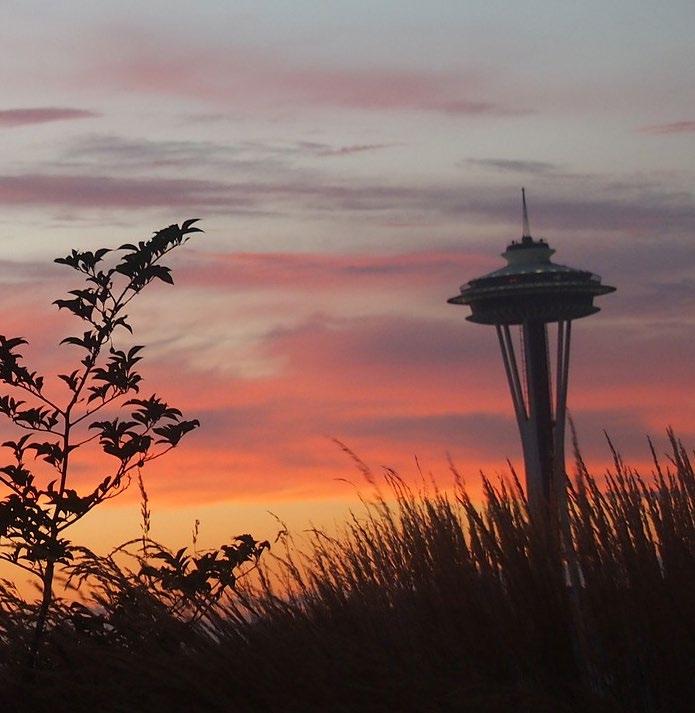
Friends of Waterfront Park Cultural Master Plan 6
PHOTO: CHUCK REISINGER, PIXABAY
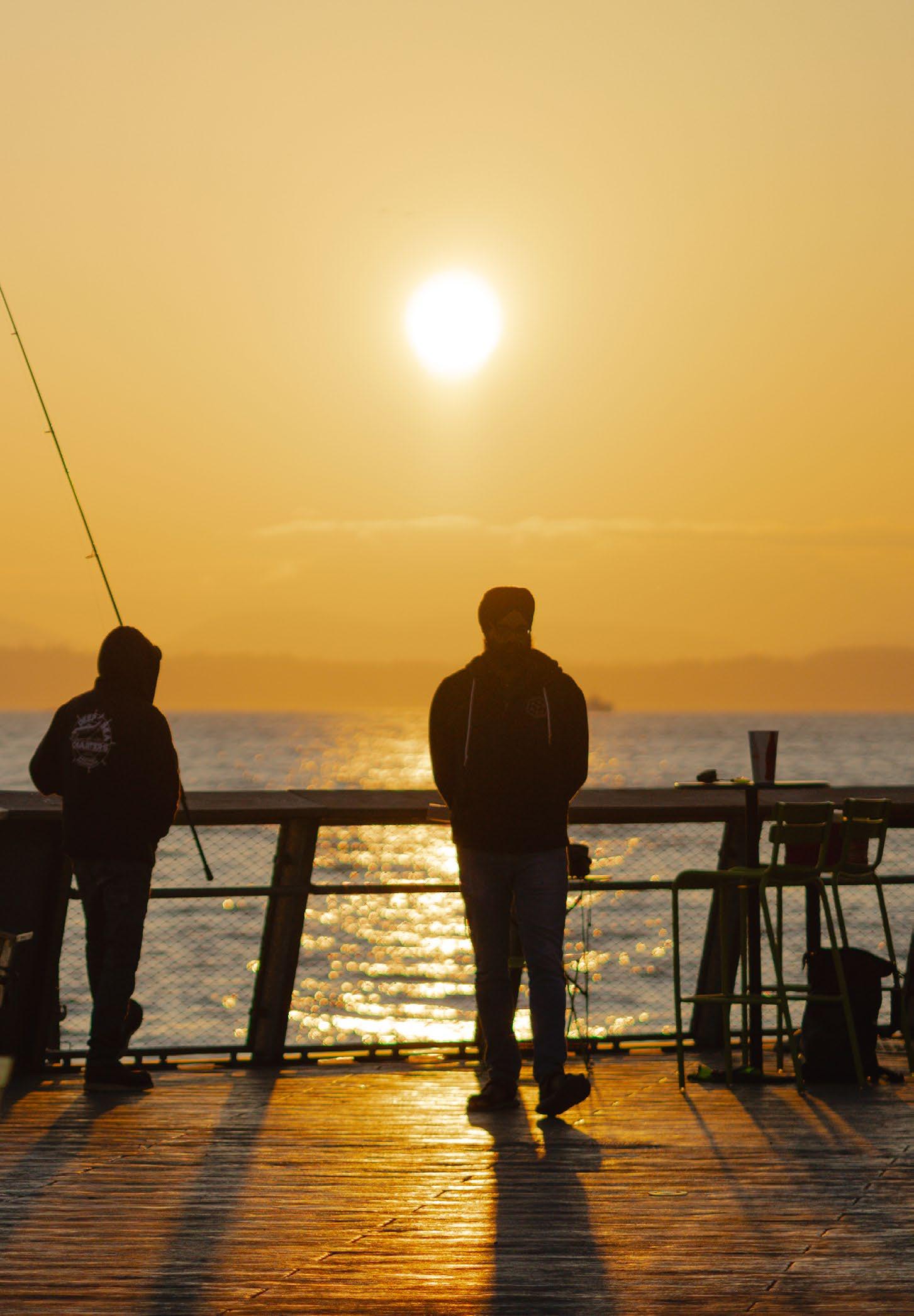
for its future: 20 acres of open space for communities to gather, for ecosystems teeming with native flora and fauna, for
What histories need to be remembered?
rest and play, imagination and healing. A once-in-a-lifetime civic project, the park is the culmination of many years of listening and planning—and it’s coming to fruition as the city stands on the verge of its latest reinvention. Like the 1962 World’s Fair, the opening of Waterfront Park is a chance to amplify Seattle culture and set the city’s trajectory for the next 50 years.
Waterfront Park is more than its physical footprint and Seattle’s front porch—more than a new Pier 58 and a revived Pier 62, an
elevated Overlook Walk, an expanded Seattle Aquarium, a transit hub, a restored beach, miles of pedestrian and bike paths, and a direct link to downtown’s many amenities. It is a living, breathing extension of people who call this place home. So what should happen here? What kinds of experiences will make Waterfront Park a welcoming reflection of who we are? What histories need to be remembered? What stories have yet to be written? Who will we become?
Organized around five core values, this Cultural Master Plan offers a roadmap and a framework for the ways millions of people will experience the park for generations.
Friends of Waterfront Park Cultural Master Plan 7
PHOTO: JO COSME, LANGSTON BEATS ON THE PIER, 2023
Executive Summary
The Journey to this Cultural Master Plan
In 2009, the city of Seattle established a Central Waterfront Committee to begin exploring a redesign of the waterfront and the possible removal of the viaduct, which had separated downtown from the water for nearly 60 years and had been damaged in the 2001 Nisqually earthquake. In 2012, voters approved a $290 million seawall bond to replace the Elliott Bay Seawall, and in 2014 Friends of Waterfront Park (Friends), formed as the independent nonprofit to steward, activate, program, and ultimately manage the park into the future. While the City of
Seattle took responsibility for designing and building the park, Friends emerged to support the private philanthropy needed to fund construction. In 2019, the viaduct came down and construction of Waterfront Park began.
A year later, portions of the park began opening to the public, starting with the rebuilt Pier 62, a large community space that previously had fallen into unsafe disrepair. Next came the Union Street Staircase, connecting downtown and Pike Place Market to the waterfront and featuring two large-scale artworks by Norie Sato. Then, in 2023, Pioneer Square Habitat Beach made its debut near Ballast Island, the site of Native encampment in the face of exclusionary laws and acts of violent displacement.

Friends of Waterfront Park Cultural Master Plan 8
PHOTO: ERIK HOLSATHER, PIER SOUNDS, 2023
As the park moves closer to opening the full 20 acres in 2025, Friends sees an opportunity to engage the local community in envisioning programming for the future. With support from Third Way Creative, in 2023 the organization convened a series of conversations across the city to explore ideas for events, artwork, food, and vending, as well as ways the park could reflect community values and ignite positive change for Seattle and the people who call it home. These conversations involved more than 142 people in 11 round table sessions that centered Indigeneity and community voices. Grounded in an authentic commitment to racial equity, the process itself modeled the creativity and collaboration that will be hallmarks of Waterfront Park.
These conversations revealed a wealth of meaningful possibilities for the park as it moves ahead, consistently returning to a core set of values that represent Seattle—values that shape and define this Cultural Master Plan.
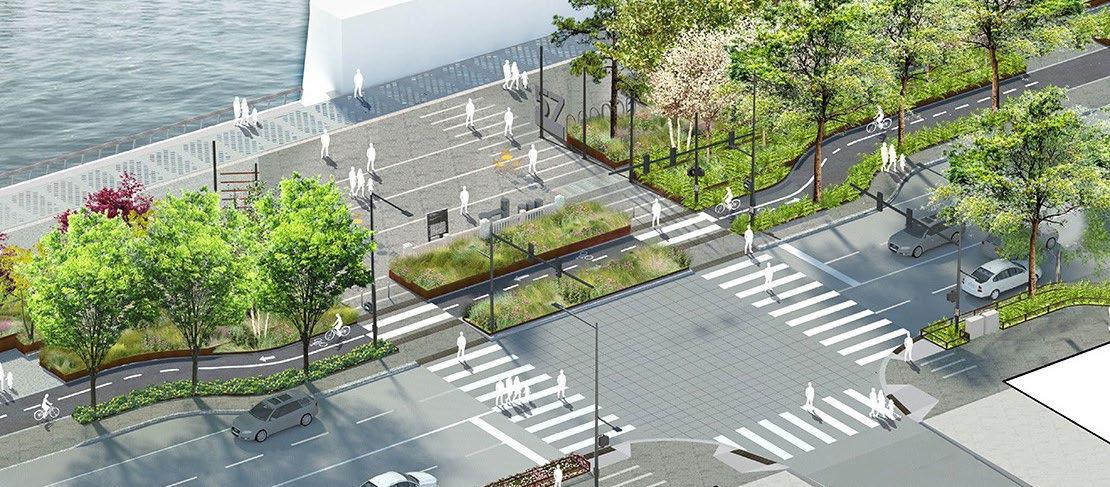
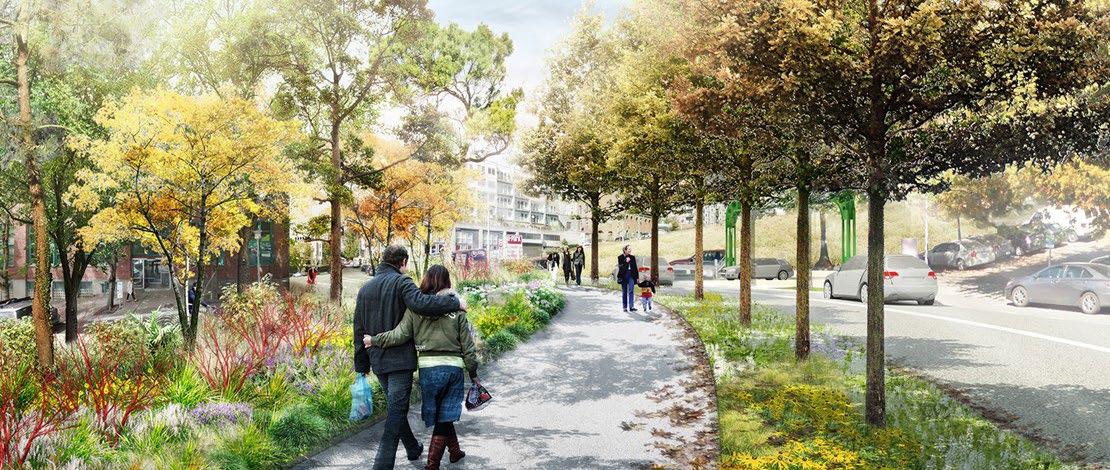
Friends of Waterfront Park Cultural Master Plan 9
RENDERING: FIELD OPERATIONS, EAST SIDE INTERSECTIONS
RENDERING: FIELD OPERATIONS, PROMENADE
Belonging

10
PHOTO: JESSICA LEA, WABA KOREA FESTIVAL, 2023, MORNING STAR KOREA CULTURAL CENTER
Waterfront Park is a place for everyone .
These are the hallmarks of belonging, of having a place where you fit, a place where you feel at home, a place that’s truly yours. At Waterfront Park, everyone is always invited to stop or stay a while: A group of friends meets up on their way to a game in Sodo, grabbing a bite to eat as they walk south along the promenade. Grandparents watch their grandchildren play on Habitat
Beach, giggling as they skip rocks into the Salish Sea and climb on sandbag-like sculptures by Buster Simpson. A newly emigrated young couple stands on the overlook, taking in the views of the Olympics on a crisp sunny day for the very first time. Bicyclists and wheelchair users roll along Railroad Way as commuters stream in and out of Colman Dock. And so on and so forth, countless scenes like these play out all day long every day.
A home reveals the history of the people who live—and have lived—there.
shores since time immemorial, where the gritty and working legacy of the port is constantly visible in its huge orange cranes, and where small vendors offer delicious foods and beautiful wares from around the world, celebrating Seattle’s vibrant immigrant communities and their cultures. Whether in the quiet moments of early dawn or the constant activity of a major festival on Pier 62, this free and accessible space that is our Waterfront Park, and the moments that will continue to shape it, belong to us all.
But beyond the regular bustle of daily life, a home reveals the history of the people who live—and have lived—there. So it is at Waterfront Park, where the Coast Salish people have strolled along these
Welcome home.
Friends of Waterfront Park Cultural Master Plan 11
Comfort. Togetherness. Safety. Acceptance. Connection.

The Origins of “Belonging”
In 1995, social psychologist Roy Baumeister and psychologist and neuroscientist Mark Leary published a landmark research paper about the importance of belonging to overall well being. Their work demonstrated that belonging is not only a universal human need, it also has been a driving force in the survival of humanity. Thirty years later after this breakthrough paper was published, leaders in the social sciences continue to emphasize belonging as essential to addressing some of today’s greatest challenges—from loneliness among elders to depression among teens. Like all places where people gather, public spaces can play a part in stimulating belonging for everyone who uses them—and these efforts can have far-reaching benefits in a community.
Friends of Waterfront Park Cultural Master Plan 12
PHOTO: JO COSME, SPOTLIGHT ON THE WATERFRONT, 2023, DANDY
Goals, Strategies & Outcomes
The goals, strategies, and outcomes below were developed through an extensive series of listening sessions and are intended to guide the way people experience Waterfront Park’s programming managed by Friends.
Goal Waterfront Park should reflect the full breadth and diversity of the Seattle region and its rich cultures, a place where stories are shared, history is interrogated, and curiosity is explored.
Friends of Waterfront Park Cultural Master Plan 13
Strategies
Offerings at Waterfront Park are provided and used by the community in ways that feel authentic.
- Program the Park with community to reflect the full diversity of the region
- Maintain elements of grit and imperfection by keeping rugged elements on the Waterfront


- Be a place of innovation and future thinking, grounded in local history and culture
- Use technology to help access the Park’s amenities remotely and share information about programs
Friends of Waterfront Park Cultural Master Plan 14
PHOTO: JOCELYN R.C., FRIENDS X REI S’MORES ON THE SHORE, 2023
PHOTO: JO COSME, REN XUE QIGONG, 2023
Strategies


All ages, races, cultures, abilities, and incomes can enjoy an inclusive Waterfront Park.
- Ensure safe and affordable activities for families and youth, fostering space for intergenerational experiences
- Make communications and wayfinding available in multiple languages, ensuring these cultures are reflected in the Park’s activities
- Create a space where everyone who lives, works, or plays in Seattle feels welcomed and seen
- Ensure all aspects of the Park are physically accessible to the broadest possible audience
Friends of Waterfront Park Cultural Master Plan 15
PHOTO: JO COSME, INDIGIQUEER, 2023
PHOTO: SEATTLE AQUARIUM POP-UP, 2023
Outcomes
Park resources are shared with historically excluded groups, supporting their cultural expression and economic selfdetermination, and allowing a sense of community agency over Waterfront Park and its programs.
Visitors experience Waterfront Park as a vibrant and inclusive gathering space where they are welcomed and feel a sense of belonging, emotional and physical safety, and connection to others.
Friends of Waterfront Park Cultural Master Plan 16
What Community Voices Had to Say
Let’s start a collective dream for our city? One where you can create belonging and connection.
Where we can hold that in Perpetuity?
I feel like I live in a city built into a forest. If you are walking in a park, you will eventually end up back into community.
When you ride your bike along the pathway you smell different food and hear music. Rush hour bike traffic is actually enjoyable.
The water will attract people who want to move here, people from all over the world. The Waterfront should taste like the whole world. But with places to sit.

Friends of Waterfront Park Cultural Master Plan 17
READ THE FULL POEM “DREAM CITY” ON PAGE 58
PHOTO: RAMZEY STAPLES, MASSIVE MONKEES DAY, 2023
Land Stewardship
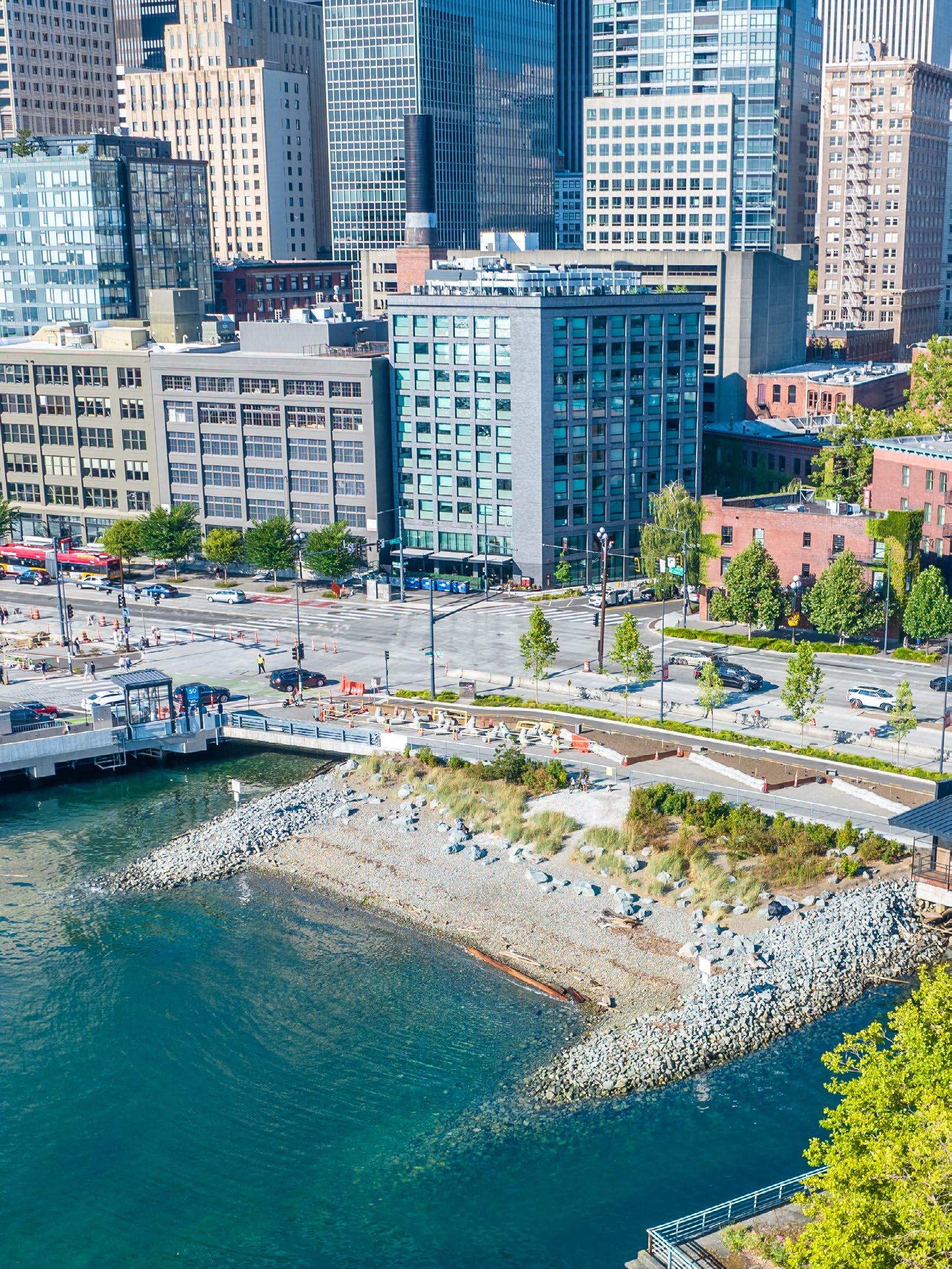
18
PHOTO: ERIK HOLSATHER, HABITAT BEACH
A thriving ecosystem connects us to nature.
Coast Salish people have been living in harmony with the land and waters of Seattle for thousands of years. Then, as now, they relied on the natural world for everything from food to clothing, medicine to transportation, storytelling to spirituality, weaving rich culture from their experiences with wildlife. Today, they continue to be essential stewards of our region’s ecosystems—including the downtown waterfront.
But, for most of a century, downtown Seattle largely lost its connection to its natural coastline. As the city industrialized, two behemoth structures severed the city’s core from Elliott Bay. In 1934, a 7,000-foot concrete seawall eliminated downtown beaches, destroying intertidal habitats and ultimately decimating salmon populations. Then, in 1953, the first segment of the Alaskan Way Viaduct opened, placing an
elevated freeway between the city and the Salish Sea.
After several decades, however, earthquakes and erosion insisted on change, and a vision emerged for restoring the shoreline and reconnecting the city
of concrete to encourage vegetation and support marine invertebrates, such as shellfish. It features shelves and benches that create places for marine life to hide and find food, forming a shallow corridor where juvenile salmon can swim safely as they make the precarious journey from the
A vision emerged for restoring the shoreline and reconnecting the city to the water.
to the water. In 2012, Seattle voters overwhelmingly approved a bond to replace the seawall. The viaduct followed suit, coming down in 2019, with a promise to the community to manifest a new, green waterfront.
Completed in 2017, the new seawall uses textured panels rather than smooth slabs

Friends of Waterfront Park Cultural Master Plan 19
RENDERING: FIELD OPERATIONS, PROMENADE
A thriving ecosystem connects us to nature.
Duwamish River to the Pacific Ocean. On land, Waterfront Park mimics the natural shoreline with thousands of new trees and native plants, which reduce the urban heat island effect, support mental and physical health, and help to filter more than 6 million gallons of stormwater every year. The rebuilt Pier 62 offers its own ecological benefits— replacing the old pier’s creosote deck and pilings with nontoxic materials. And a new Habitat Beach returns the tide to the shores of Seattle’s urban core.
Now the people of Seattle once again have a public space on the waterfront where nature can flourish throughout the seasons. In spring, the juvenile salmon arrive and the trees grow the leaves that shade the promenade in summer. By autumn, the salmon have gone and by winter the leaves have fallen. And, as it has been since time immemorial, people will gather on the shoreline all year round.
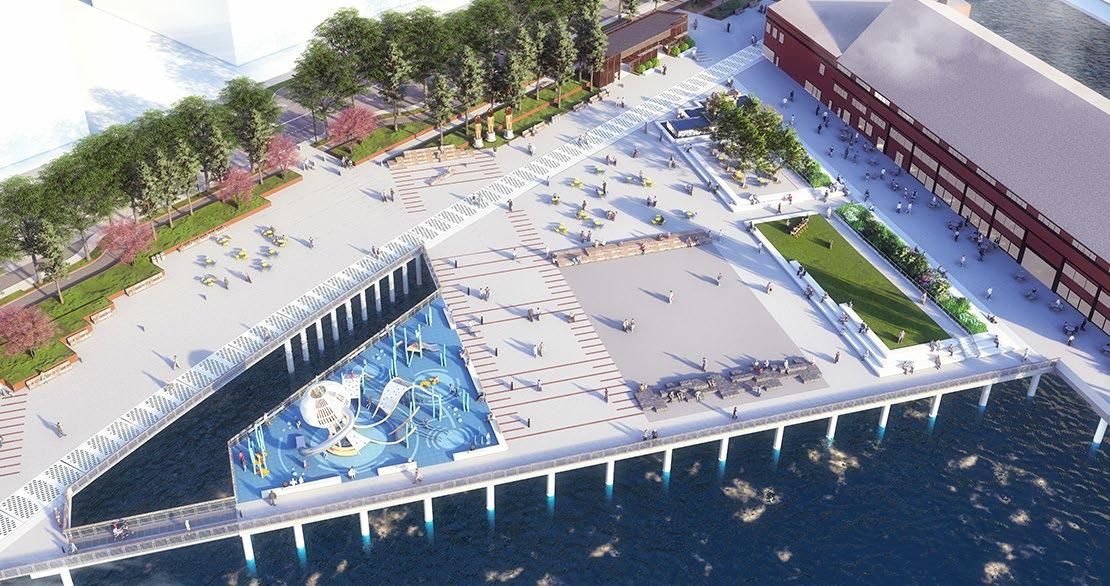
Now the people of Seattle once again have a public space on the waterfront where nature can flourish throughout the seasons.
Friends of Waterfront Park Cultural Master Plan 20
RENDERING: FIELD OPERATIONS, PIER 58
Indigenous Programming So Far
Friends of Waterfront Park began offering programming focused on local Indigenous communities in 2020, presenting and hosting several major events each year since. Friends produces the annual Indigiqueer Festival, which showcases the beauty and power of Two-Spirit people during Pride month, and it hosts the longstanding annual Salmon Homecoming, which supports the revival of canoe culture. All Indigenous programming at the park is— and will be—by and for Indigenous people, while being open to the wider community.
Friends has also been cultivating leadership and partnerships to support its Indigenous programming. Its Pulling Together Committee includes more than a dozen Indigenous people from the Seattle area who provide invaluable guidance and knowledge. This committee works alongside the Friends’ Curator of Indigenous Programs. Additional partnerships are also underway, including an effort with yəhaw̓ Indigenous Creatives Collective, to develop an Indigenous artist roster, which will connect people with opportunities to create temporary art projects in the park while reducing the application burden on Indigenous artists.

Friends of Waterfront Park Cultural Master Plan 21
PHOTO: JO COSME, SALMON HOMECOMING, 2023, PERFORMER: SHANE MOSES
Goals, Strategies & Outcomes
The goals, strategies, and outcomes below were developed through an extensive series of listening sessions and are intended to guide the way people experience Waterfront Park’s programming managed by Friends.
Goal
Connection
to the land, water, and mountains is
essential to the character of
Waterfront
Park, which nurtures and sustains the land as well as those who continue to care for it.
Friends of Waterfront Park Cultural Master Plan 22
Strategies
Center Indigeneity.
- Beyond acknowledgement, explore how and where resources and decision-making can be given to Coast Salish communities to support cultural and economic self-determination
- Pursue ways that land back principles can be applied to park programming and stewardship
- Ensure the presence of the Lushootseed language in the park itself as well as in Friends’ materials


- Accommodate and resource Indigenous artists, storytellers, and keepers of traditional knowledge to share their crafts
Friends of Waterfront Park Cultural Master Plan 23
PHOTO: JO COSME, SALMON HOMECOMING, 2023
PHOTO: JO COSME, SALMON HOMECOMING, 2023
Strategies
Foster connections to water and land.
- Create a strategy that considers the impacts of projects and programs on the land and water
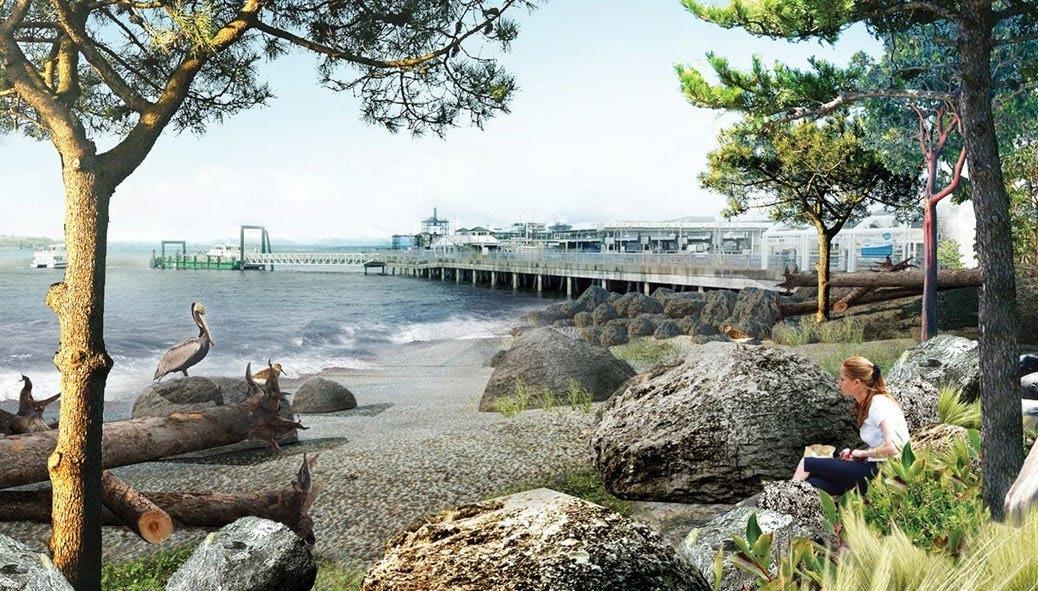
- Embed historic and interpretive wayfinding, both physical and virtual, that tells the story of the land and its
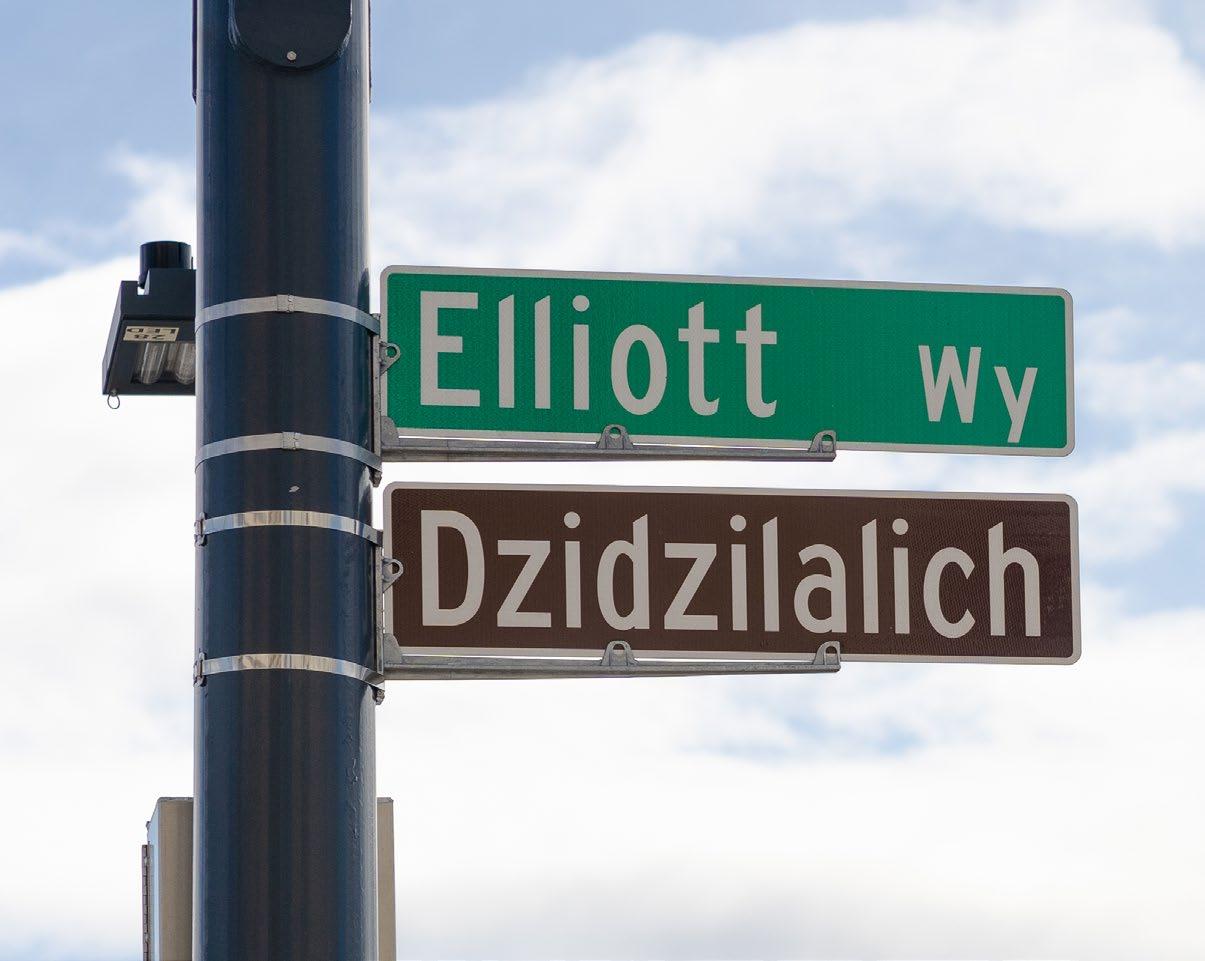
Maintain balance between the natural and built environment.
- Share history of the built environment over time, including its environmental impact
- Do not overemphasize infrastructure over culture; rather create a balance between the two
Friends of Waterfront Park Cultural Master Plan 24
RENDERING: FIELD OPERATIONS, HABITAT BEACH
PHOTO: JO COSME, DZIDZILALICH UNVEILING/ELLIOTT WAY OPENING CEREMONY, 2023
Outcomes
Coast Salish communities have authentic presence and representation.
The natural elements of Waterfront Park are nurtured, maintained, and in balance.
Friends of Waterfront Park Cultural Master Plan 25
What Community Voices Had to Say
Can we build a place that feels like it’s “of this place?”
Whose ancestral land is this?
Not what government proclaimed but who does the land remember? Where are we?
We should really know this place?
Consistency & sustainability, Hub for the free community building and arts.
We need to prioritize our own people.
The People who wake up to the mountains and the ocean, Plants grow, We need to continually feed a place.
Open invitation It’s going to become our home too.

Friends of Waterfront Park Cultural Master Plan 26
READ THE FULL POEM “A PLACE FOR BEAUTY AND POSITIVITY” ON PAGE 59.
PHOTO: MICHAELA, PIXABAY
Healing & Sustenance

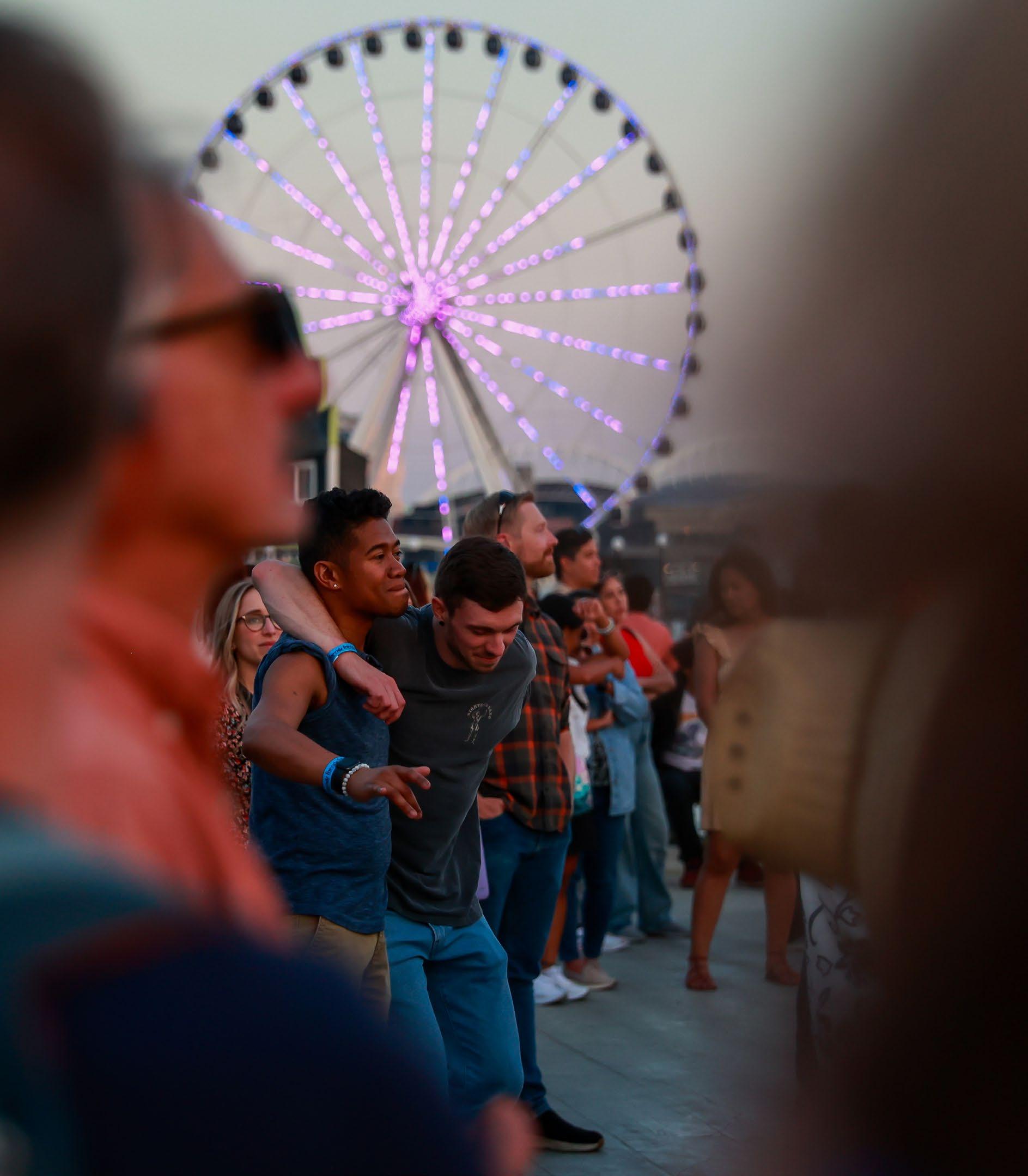
27
PHOTO: ADAM LU, WATERFRONT BLOCK PARTY, 2023
A clear understanding of history leads to a healthy future.
Like Seattle broadly, the downtown waterfront bears the scars and unhealed wounds of its history—harms that require our ongoing acknowledgement, restitution, and care. They, too, are part of the cellular memory stored along the coastline, a body laden with generational traumas in need of healing.
Waterfront Park is a place for that healing, for telling the truth about the past and its lasting impacts, levied most of all upon Seattle’s communities of color, beginning with the Coast Salish people.
In 1850, Euro-American settlers began to settle in the city, and within a few years they had forced most Native people onto reservations using a pair of treaties—all the while relying on them for knowledge, resources, and labor. Not long after, colonists took to burning down Native longhouses and stamping out Native culture.
Chinese immigrants were the next to suffer at the hands of the settlers. By the 1880s, they comprised nearly 10% of the city’s population, many having come to the United States looking for work in lumber mills and railways. But racist sentiment and labor competition were mounting, and in 1886
to leave their homes and businesses and imprisoned in concentration camps, euphemistically renamed “internment camps,” for nearly three years during WWII. Their incarceration created labor shortages, particularly on the railroads and in agriculture. Latine workers—from
Waterfront Park is a place for healing, for telling the truth about the past and its lasting impacts.
a mob of white men not only pushed the Chinese community out of their waterfront homes, but expelled many Chinese settlers from the city, forcing them to rebuild their settlement within Pioneer Square.
These violent exclusionary acts didn’t stop in the 20th century. In 1942, Japanese Americans made up Seattle’s largest ethnic minority—and yet they were forced

Friends of Waterfront Park Cultural Master Plan 28
RENDERING: FIELD OPERATIONS, QWALSIUS-SHAUN PETERSON’S FAMILY
A clear understanding of history leads to a healthy future.
communities that traced mostly to families that fled the Mexican Revolution—replaced them, only to be subjected to terrible maltreatment on the job.
To look forward, we must continually look back.
Black Americans first started arriving in the 1880s in search of work, coming to Seattle for jobs left vacant by striking coal miners. The Great Migration followed, bringing a wave of Black people from the south to Seattle. They, too, faced violence and exclusion, including racist housing practices, such as redlining, that profoundly restricted their ability to own homes and build generational wealth.
In more than 50 years since then, Seattle’s communities of color have survived against
the steep odds of systemic racism, building cultural centers and mutual aid enterprises to protect themselves and their cultures. Enduring pain and inequities are evident in even the most recent chapters in our history: the pandemic, the homelessness crisis, and gun violence among them.
Why dwell here? Because to look forward, we must continually look back. Waterfront

Park is making space for people to heal and find sustenance—in reflection, art, communion, culture, food.
Note: For more information on these histories, we encourage you to visit Densho, HistoryLink.org, Black Heritage Society of Washington State and Wing Luke Museum.
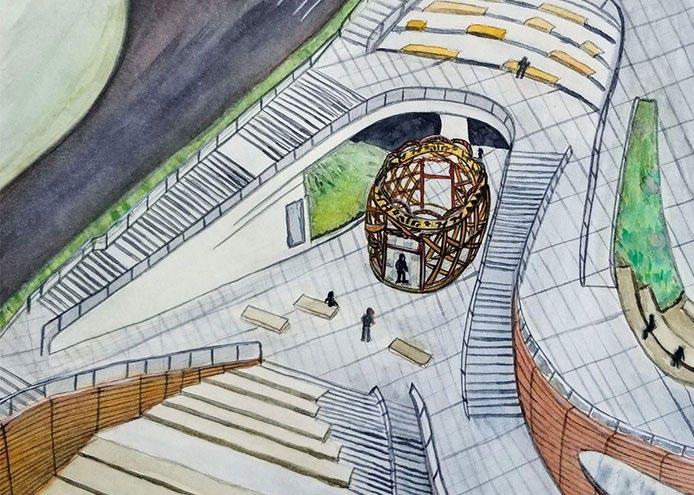
Friends of Waterfront Park Cultural Master Plan 29
RENDERING OF MTK MATRIARCHS ART AT SALISH STEPS
WEAVER ON THE SKOKOMISH RESERVATION, 1095. PHOTO BY ASAHEL CURTIS, COURTESY OF WASHINGTON STATE HISTORICAL SOCIETY

Racism as a Public Health Crisis
In June of 2020, as people across the country and the city were rising up against racism in the wake of the murder of George Floyd in Minnesota, King County officially declared racism a Public Health Crisis, recognizing it as an underlying systemic root cause of negative and disproportionate impacts affecting wellbeing in communities of color. The county committed to centering Black and Indigenous communities—both of which face disproportionate health impacts—in developing solutions that aim to repair harm, and has since mobilized $25 million in support of that effort.
Friends of Waterfront Park Cultural Master Plan 30
PHOTO: JOVELLE TAMAYO / CROSSCUT
Goals, Strategies & Outcomes
The goals, strategies, and outcomes below were developed through an extensive series of listening sessions and are intended to guide the way people experience Waterfront Park’s programming managed by Friends.
Goal Waterfront Park is a space that can bring people together across differences to reflect and address harms of both the recent and historic past.
Friends of Waterfront Park Cultural Master Plan 31
Strategies
Be honest about history.
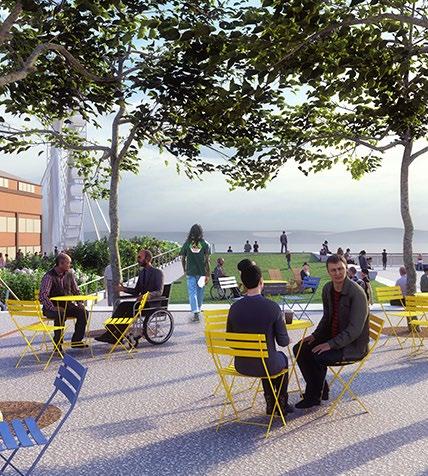
- Create artworks and wayfinding that tell the true stories of waterfront history, highlighting difficulty, resilience, and activism
- Reckon honestly with historic traumas to build deep trust and possibility
- Center impacted communities in programming and economic opportunities as a way to restore trust
Create space for moments of quiet and reflection.
- Establish areas for rest as a respite from the city and the more active spaces within the park
- Lean into discomfort with an open heart, accepting the full range of emotions with which visitors will enter the space
Friends of Waterfront Park Cultural Master Plan 32
RENDERING: FIELD OPERATIONS, PIER 58
Strategies
Waterfront Park should taste like local communities from around the world.
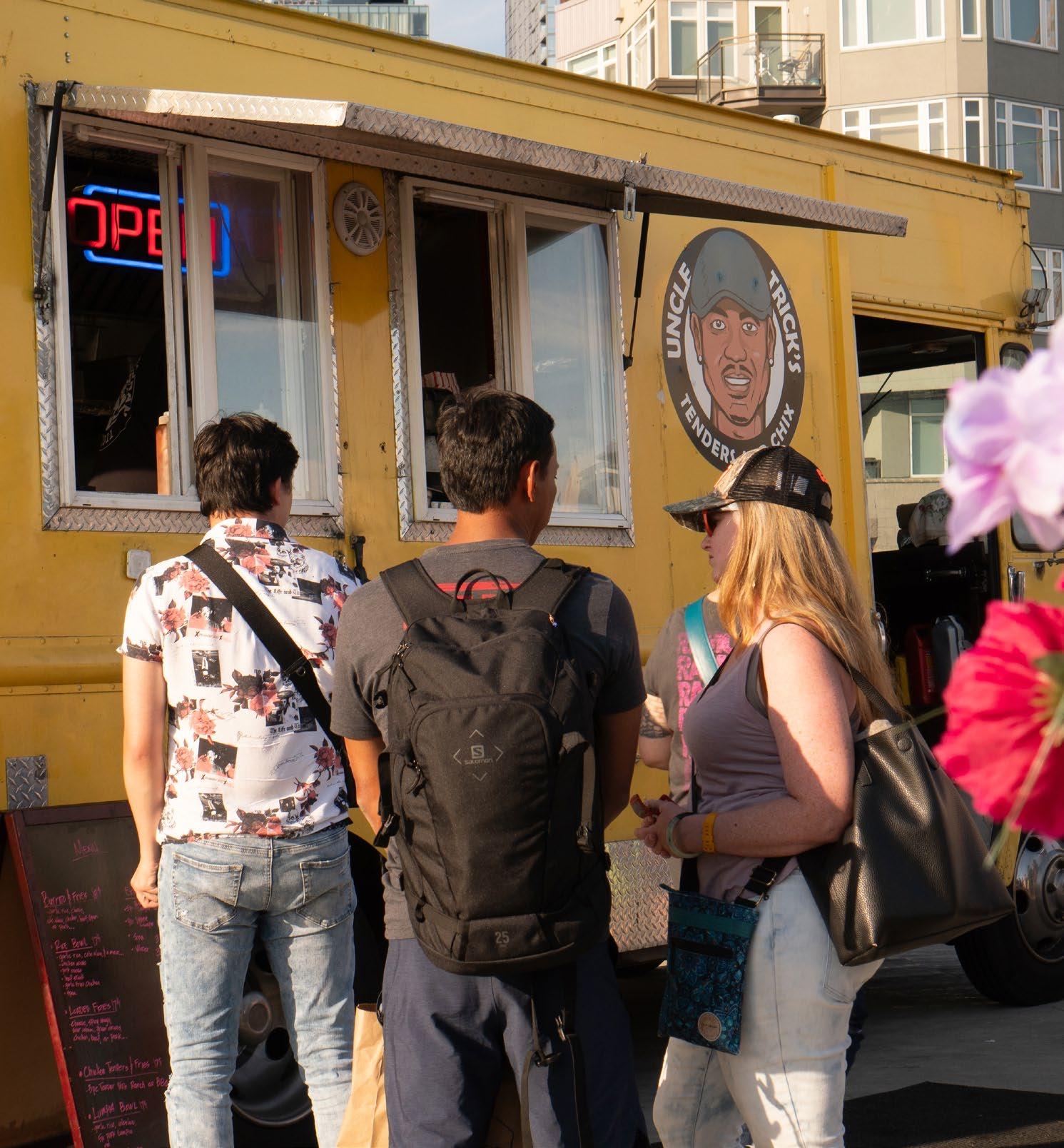
Establish a robust food vending program that features diverse and international offerings that reflect the local community
Make food vending locally focused, diverse, and easy to navigate with lower barriers to participation
Feature food and music that represents the authentic histories and cultures of Seattle

Friends of Waterfront Park Cultural Master Plan 33
PHOTO: KAYLA BLACK, INDIGIQUEER, 2023
PHOTO: BERHANU WELLS, ACLT SOUL ON THE WATER, 2023
Outcomes
True history is reflected, allowing new futures to be co-created.
Historical traumas are acknowledged, and healing begins to take hold.
Communities from all over our region and the world share their cultures through food and cultural activity.
Friends of Waterfront Park Cultural Master Plan 34
What Community Voices Had to Say
You don’t have to sacrifice who you are in these spaces.
Evolving is an important verb.
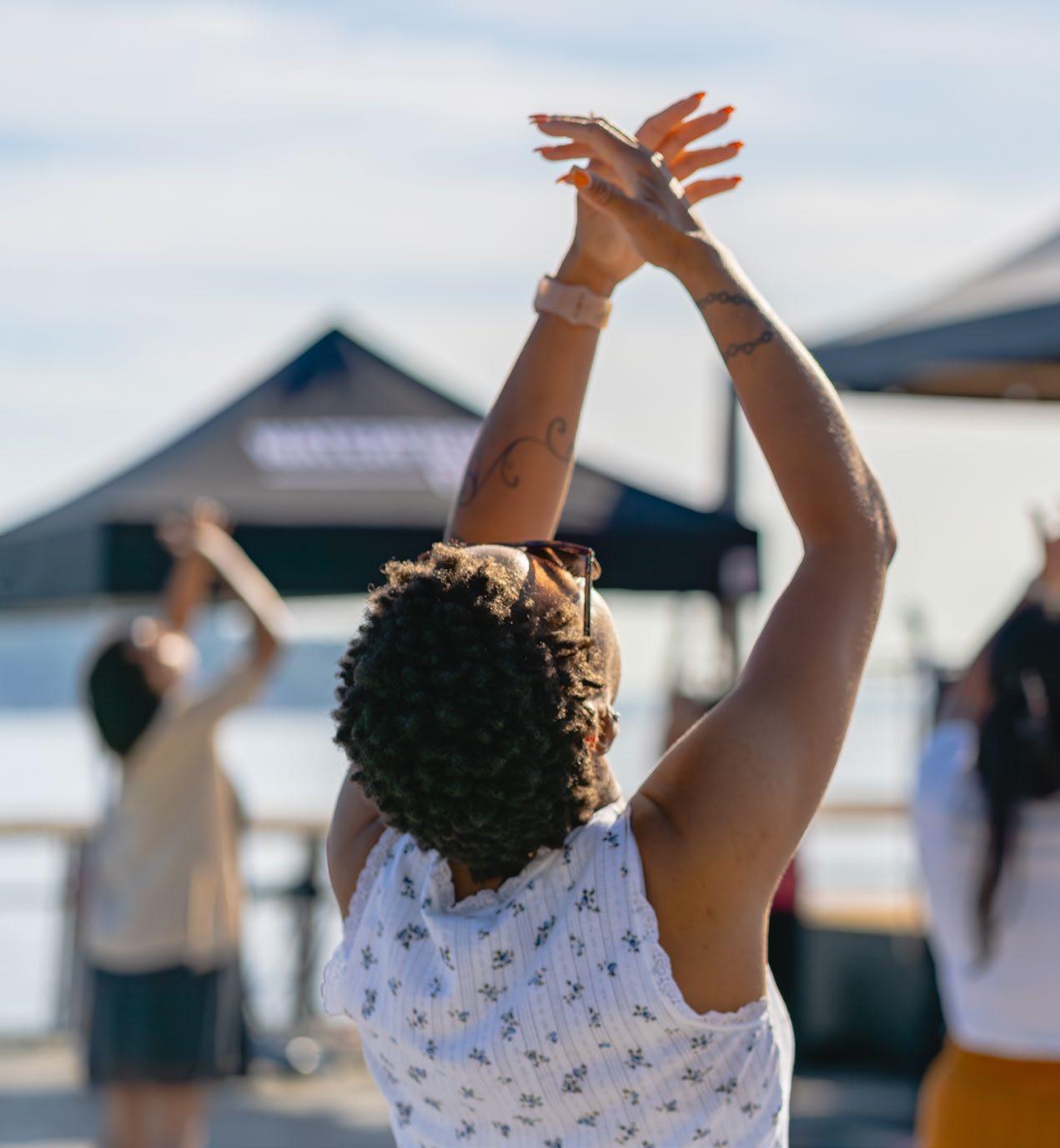
Embracing change while not forgetting our hard histories. We must tell a full story of this place if we want everyone to feel welcome. We are never going to forget the Indigenous history of this place.
Shift and replace the neo-colonial narrative. Let’s have an empowering narrative.
The Chinese Exclusion Act and Japanese internment weren’t even 100 years ago. Artists and cultural workers are at the heart of the waterfront.
Can the Waterfront be a project that pushes capital into people?
Pay the people who bring the soul power.
Can this be a place where people access Freedom, and that feeling of freedom?
This is your park.
History is storytelling, and the Waterfront is a story that is being re-written every day.
People want to be anchored here.
Nature has its resilience built into it.
Life can return to these waters, and that would be a testament to changing the course of history.
Friends of Waterfront Park Cultural Master Plan 35
READ THE FULL POEM “THERE ARE MANY IMPORTANT HISTORIES ON THE WATERFRONT” ON PAGE 60.
PHOTO: JO COSME, REN XUE QIGONG, 2023
Living Culturally

36
PHOTO: SUNNY MARTINI, XOPANTLA TIANQUIZTLI, 2023
Diverse traditions and experiences uplift and connect us.
Imagine a future day at the Park: It’s morning, and several dozen people are unfurling their yoga mats on Pier 62, getting ready for their weekly, free dropin class. As the daylight spreads over the Salish Sea, they sweep their arms above their heads in a collective sun salutation. Nearby, the cafe on Overlook Walk is opening up for a special day featuring slow and deliberate coffee rituals in partnership with a local small business. Already the nutty aroma of freshly roasting beans is drifting on the morning’s breeze.
Imagine a future day at the Park
At the south end of the park, a bevy of food trucks is assembling for a lunchtime festival of Asian foods featuring local restaurants
and chef collaborations. By 11 a.m., people are queued up for everything from Vietnamese bánh mì to Filipino lumpia.
As the afternoon wears on, the day’s buskers and street performers add to the atmosphere up and down the promenade: Puppeteers surprise tourists and locals alike. Singer-songwriters strum soulful tunes. Children practice Native songs at Habitat Beach.
Tonight also marks the opening of a new temporary art exhibit at Pier 62 celebrating the city’s musical legacies, and by early evening a small crowd is forming for the celebration. There along one side, artists sell their handmade creations at a series of booths set up like a mini bazaar. Waves of kids play with the giant chess set and learn the hustle from a beloved local dance instructor. And as the sun falls behind the

Olympics in the distance, a DJ begins spinning records.
Every day all year long, Waterfront Park immerses the community in countless experiences like these. Always moving and changing, they offer a taste of the cultural richness that thrives in all corners of the city, uplifting its people, reminding us of who we are.
Friends of Waterfront Park Cultural Master Plan 37
RENDERING: FIELD OPERATIONS, PIER 58
Soundtrack of the City

Seattle is a music town, and already many wildly diverse artists have performed in Waterfront Park, representing a dizzying array of local cultures and bringing people together for shared experiences along the downtown shoreline: singersongwriters, rappers, electronic beatmakers, pop artists, soul singers, rockers, bossa nova guitarists, funk bands, fandango, folklorico and more. Both locally beloved and relatively unknown, these performers infused the park with the rhythms and melodies that bring the city to life everyday. A Spotify playlist compiled by Friends highlights some of the music that was heard on the waterfront from 2020 to 2023. Follow the QR code to listen for yourself!

Friends of Waterfront Park Cultural Master Plan 38
PHOTO: JO COSME, RHAPSODY PROJECT, 2023
Culture through Partnership
Diverse cultural programming in Waterfront Park taps into the great wealth of partnerships that Friends has with groups from all around the region. Whether hosting big events like the WABA Korea Expo & Festival, Africatown’s Soul on the Water, and Massive Monkees’ all-day breakdance battle or presenting two-hour performance takeovers by organizations like Northwest Tap Connection, Vera Project, Melody Institute, and Red Eagle Soaring, Friends provides a platform for Seattle’s cultural leaders to shine.

Friends of Waterfront Park Cultural Master Plan 39
PHOTO: RAMZEY STAPLES, MASSIVE MONKEES, 2023
Goals, Strategies & Outcomes
The goals, strategies, and outcomes below were developed through an extensive series of listening sessions and are intended to guide the way people experience Waterfront Park’s programming managed by Friends.
Goal Waterfront Park should feel like an immersive cultural experience, one that amplifies Seattle’s authentic stories to the city and the world.
Friends of Waterfront Park Cultural Master Plan 40
Strategies
Foster cultural and economic selfdetermination through both formal and informal programming.

- Support and incubate vendors and performers
- Curate special marquee events and festivals as for a dynamic range of year-round programming of different scales

- Structure and support busking and street performance without overregulating them
- Offer economic opportunities by providing space and place for community-led programming
- Facilitate the exchange of stories, personal and historic, through dance, music, and play
Friends of Waterfront Park Cultural Master Plan 41
PHOTO: JESSICA LEA, WABA KOREA FESTIVAL & EXPO, 2023
PHOTO: JO COSME, TOTEM STAR, 2023
PERFORMER: MIRABAI KUKATHAS
Strategies
- Empower community to shape the park’s curation, in particular the Pulling Together Committee, the Community Connections Committee, the Accessibility Advisory Committee, and the voices of partners’ youthdriven programming committees. Support their work with both budget and authority

Develop responsive, relevant, and emergent programs and processes.
- Establish a temporary public art program that includes interactive artwork
- Create opportunities for community to participate in art-making
- Amplify smaller organizations
- Offer year-round programming
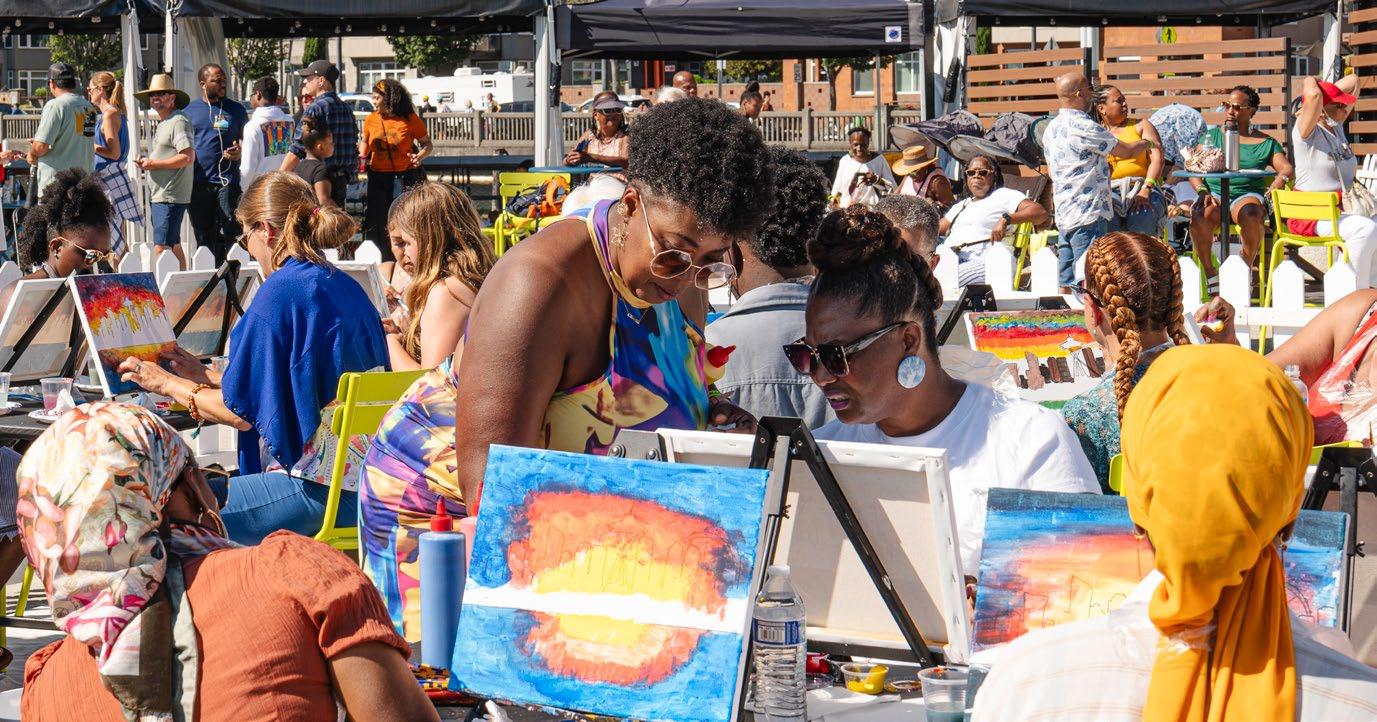
Friends of Waterfront Park Cultural Master Plan 42
PHOTO: JO COSME, INDIGIQUEER, 2023
PHOTO: BERHANU WELLS, ACLT SOUL ON THE WATER, 2023
Outcomes
Friends of Waterfront Park amplifies overlooked cultures and stories.
Waterfront Park is a destination for authentic Seattle cultural experiences of all kinds.
Programming is both intentional and flexible, meeting emerging needs over time.
Friends of Waterfront Park Cultural Master Plan 43
What Community Voices Had to Say
Local artisans as vendors
Passive art and music to enjoy
Pop-up experiences
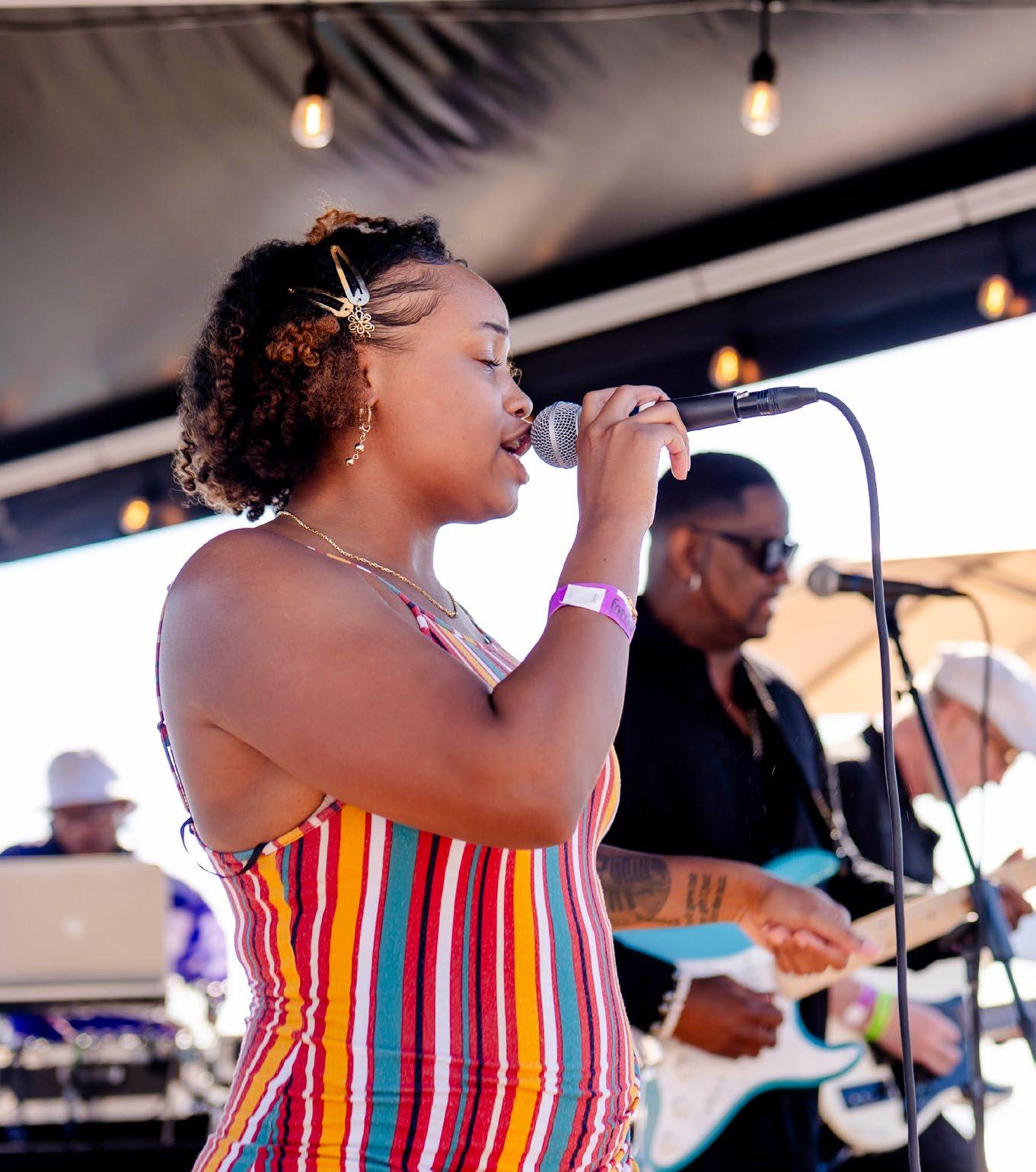
Busking- it doesn’t always need to be amplified sound
Bikes and less cars
World-class cities should, on some level, have an attraction to the rest of the world.
We will have physical and emotional safety at all areas of park.
Stand on the overlook walk, and see
A place youth have to belong.
Activations from dusk to dawn.
BIG concerts next to space where you can have quiet conversation.
Sea lions
Places to work on our fitness.
Community gardens
Lots of languages
Music and clapping Waves, and wind
Friends of Waterfront Park Cultural Master Plan 44
READ THE FULL POEM “WHAT MAKES A WORLD CLASS CITY?” ON PAGE 61.
PHOTO: BERHANU WELLS, ACLT SOUL ON THE WATER, 2023
PERFORMER: ZHANEA JUN
Neighborhood Reciprocity

45
PHOTO: JOSH HILD / PEXELS
Activity multiplies throughout the city.
Up and down the length of Waterfront Park, Seattle pulses with movement in every direction: People streaming down the Harbor Steps at University Street, people making their way from Pike Place Market to the aquarium via the Overlook Walk, people walking up and down the steep streets that lead from the shoreline into the heart of the city.
Transportation infrastructure of every kind brings them here by the millions. Ferries
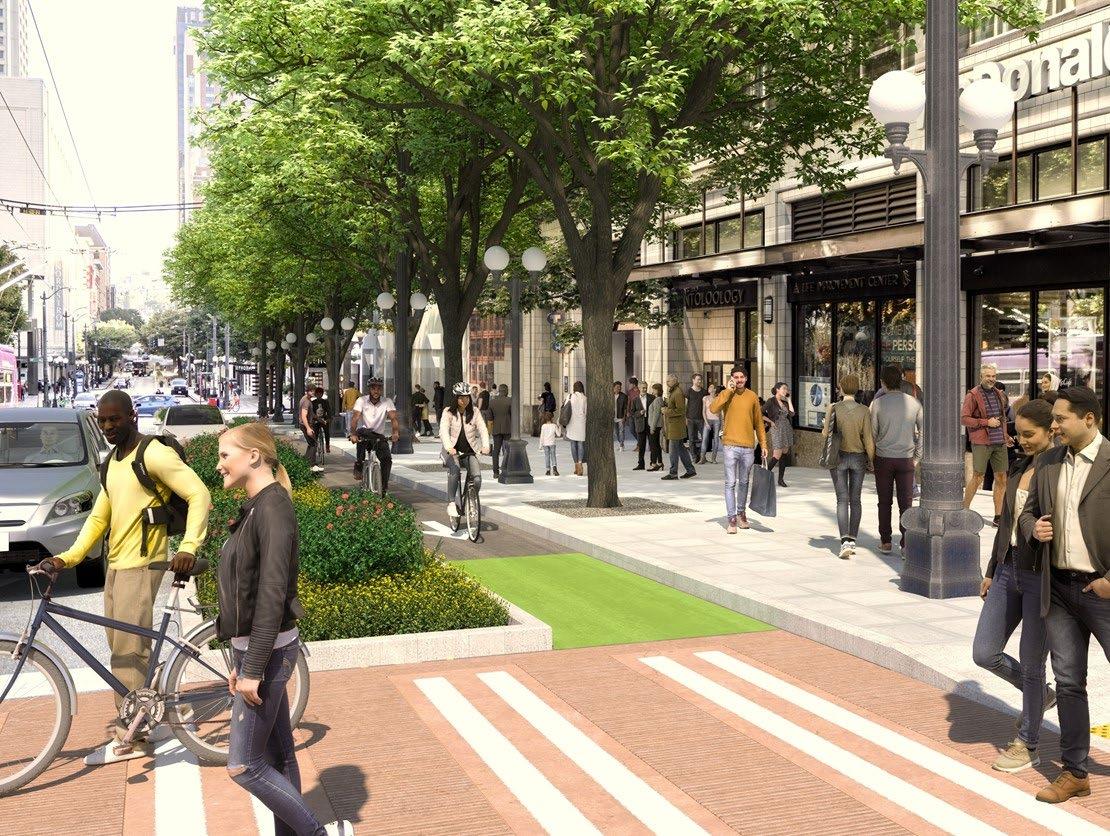
sail in and out of Colman Dock beside the West Seattle water taxi. A summertime Waterfront Shuttle goes from one end of the park to the other. Light rail stops at four nearby stations—from Westlake Center to the Chinatown-International District— as do hundreds of buses that travel to every corner of town. The monorail links to Seattle Center, the streetcar runs up Jackson Street through Pioneer Square to First Hill and beyond, and Sounder and Amtrak trains move passengers from around the region.
All of these people are the lifeblood coursing through the circulatory system of the city. Whether downtown dwellers, city residents, regional commuters, or tourists, they arrive not just from out of town, but mostly from the city’s 80 officially recognized neighborhoods, each of which has its own distinct character and culture.
Waterfront Park is a conduit for those cultures. Sparking celebration and exploration, it not only provides space for neighborhood businesses and artists
People are the lifeblood coursing through the circulatory system of the city.
to share what they love about where they live—it also inspires people to visit the city’s unique neighborhoods. This reciprocal exchange generates economic and cultural activity throughout Seattle, forging and strengthening relationships that benefit people, neighborhoods, and the park all at the same time.
Friends of Waterfront Park Cultural Master Plan 46
RENDERING: FIELD OPERATIONS

Leading People into Neighborhoods
As crowds descend on Seattle’s waterfront for major events like MLB All-Star Weekend or the World Cup, Friends has a crucial opportunity to help visitors explore the city beyond the shoreline. Guided by special maps, recommendations, and other helpful resources, people can discover local gems while providing essential support to small businesses. A meaningful influx of customers at restaurants and shops—particularly in nearby neighborhoods like the Chinatown-International District and the Central District—can play an important role in preserving the character and vitality of communities outside the downtown core, sharing the prosperity generated along the waterfront. RENDERING: FIELD OPERATIONS
Friends of Waterfront Park Cultural Master Plan 47
Goals, Strategies & Outcomes
The goals, strategies, and outcomes below were developed through an extensive series of listening sessions and are intended to guide the way people experience Waterfront Park’s programming managed by Friends.
Goal Waterfront Park should be a space that all Seattle residents feel an authentic connection to; this means building and maintaining meaningful relationships with communities and neighborhoods throughout the city.
Friends of Waterfront Park Cultural Master Plan 48
Strategies

Draw visitors from throughout the Coast Salish region, while also circulating park visitors back into Seattle’s diverse neighborhoods.

- Create a circulatory system between neighborhoods and the waterfront through programming, transit, and pedestrian infrastructure
- Work with stakeholders in all of Seattle’s areas, encouraging people to explore surrounding neighborhoods
- Feature and amplify neighborhoods and their diverse cultures in the park
Friends of Waterfront Park Cultural Master Plan 49
PHOTO: JOSH HILD / PEXELS
PHOTO: PNW_PHOTO_REPOSITORY, PIXABAY
Strategies
Embrace intermediary roles that Friends is uniquely suited to play.

- Waterfront Park can provide an unparalleled platform for neighborhoods to share their unique cultures
- Explore a “village concept” for combining multiple businesses, performers, and vendors to showcase a neighborhood’s retail, cultural, and residential identities

- As the largest civic project in 100 years, Friends can steward regional philanthropic and corporate relationships for an evolving downtown
Friends of Waterfront Park Cultural Master Plan 50
RENDERING: FIELD OPERATIONS, SALISH STEPS
PHOTO: ERIK HOLSATHER, WATERFRONT BLOCK PARTY, 2023
Outcomes
Connections are built and maintained between Friends of Waterfront Park and Seattle’s neighborhoods.
Relationships between Waterfront Park and the surrounding communities experience mutual cultural and economic benefits.
Friends of Waterfront Park Cultural Master Plan 51
What Community Voices Had to Say
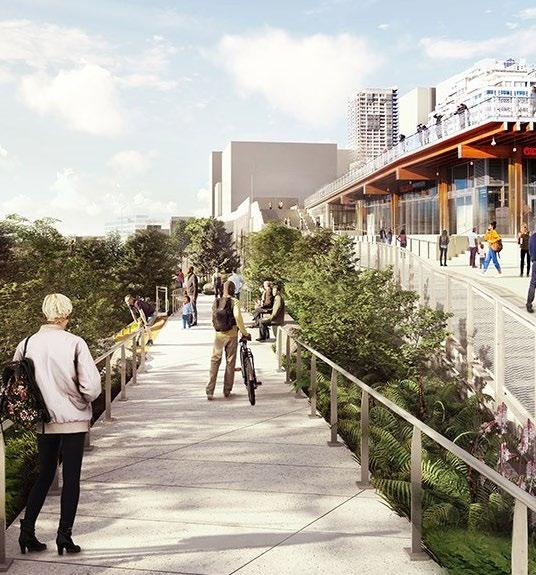
We need….
Places to check out boats, bikes and equipment
Pedicabs
A place that locals go and tourists
A balance of nature and city
Transportation shuttles
Bring the streetcar!
Tables with and without umbrellas
To Highlight different neighborhoods
We have ….
All kinds of life, Plants, animals, and all kinds of humans.
A place that gives as much as it receives.
We See
A place that looks like a pre-colonial history, without the trauma and harm.
Community Murals
Natural and clean trees and birds.
Lots of ferries and boats
Bring the maritime back
Friends of Waterfront Park Cultural Master Plan 52
READ THE FULL POEM “IT IS A JOURNEY AND A DESTINATION” ON PAGE 63. RENDERING: FIELD OPERATIONS, OVERLOOK WALK
Conclusion
Waterfront Park should be welcoming spaces for all who call Seattle home.
Recognizing Seattle’s history, Friends of Waterfront Seattle is leveraging public park programming to intentionally foster community healing, belonging and shared prosperity.
Appendix:
Community Co-Design
As this plan was being developed, the conversations we had with community generated a wealth of ideas and inspiration for Waterfront Park in the years to come. Here’s a deeper look into this collaborative effort.
As Waterfront Park continues to evolve in the years and decades ahead, we look forward to continuing these conversations, which are powerful drivers in our ongoing effort to co-create this community space.


54
PHOTO: WELCOME TABLE AT PIER 62, 2023
Community Co-Design



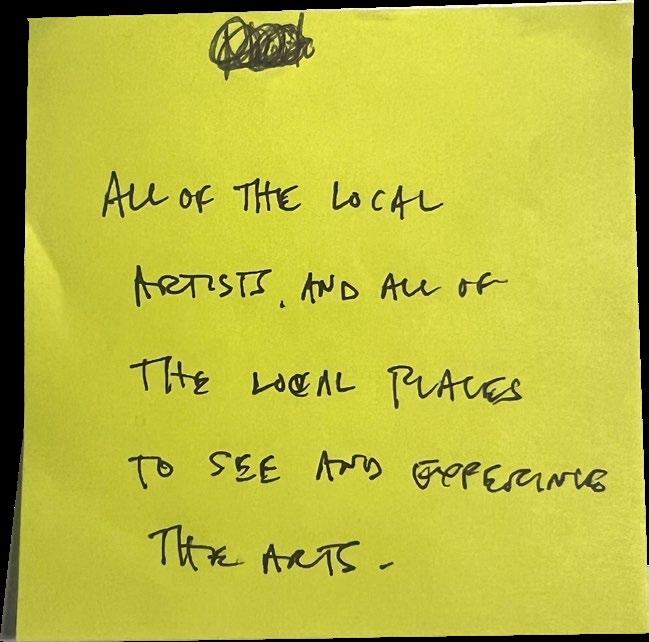
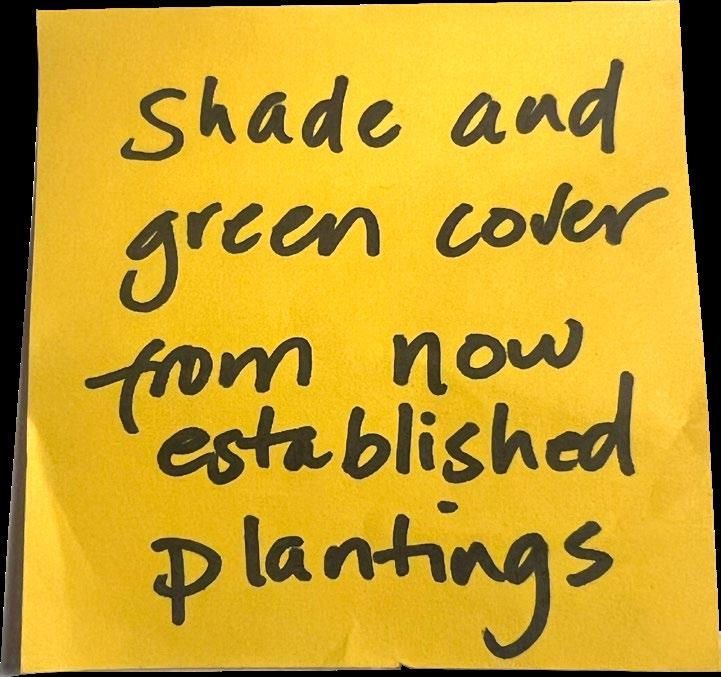


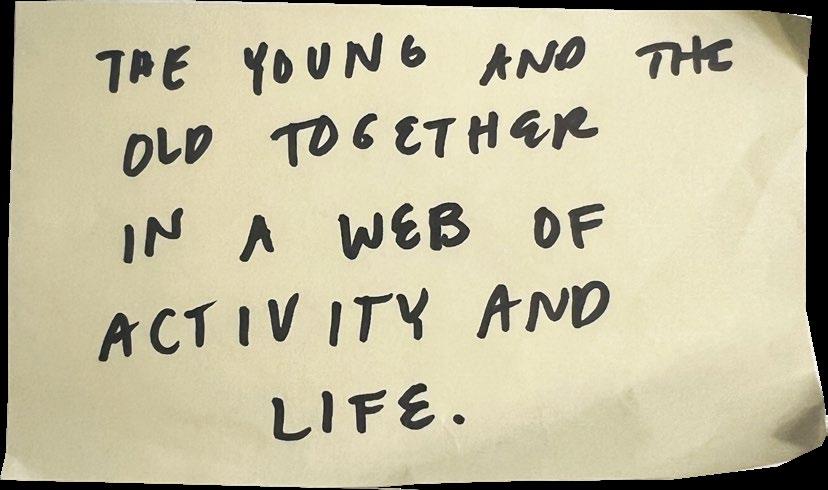
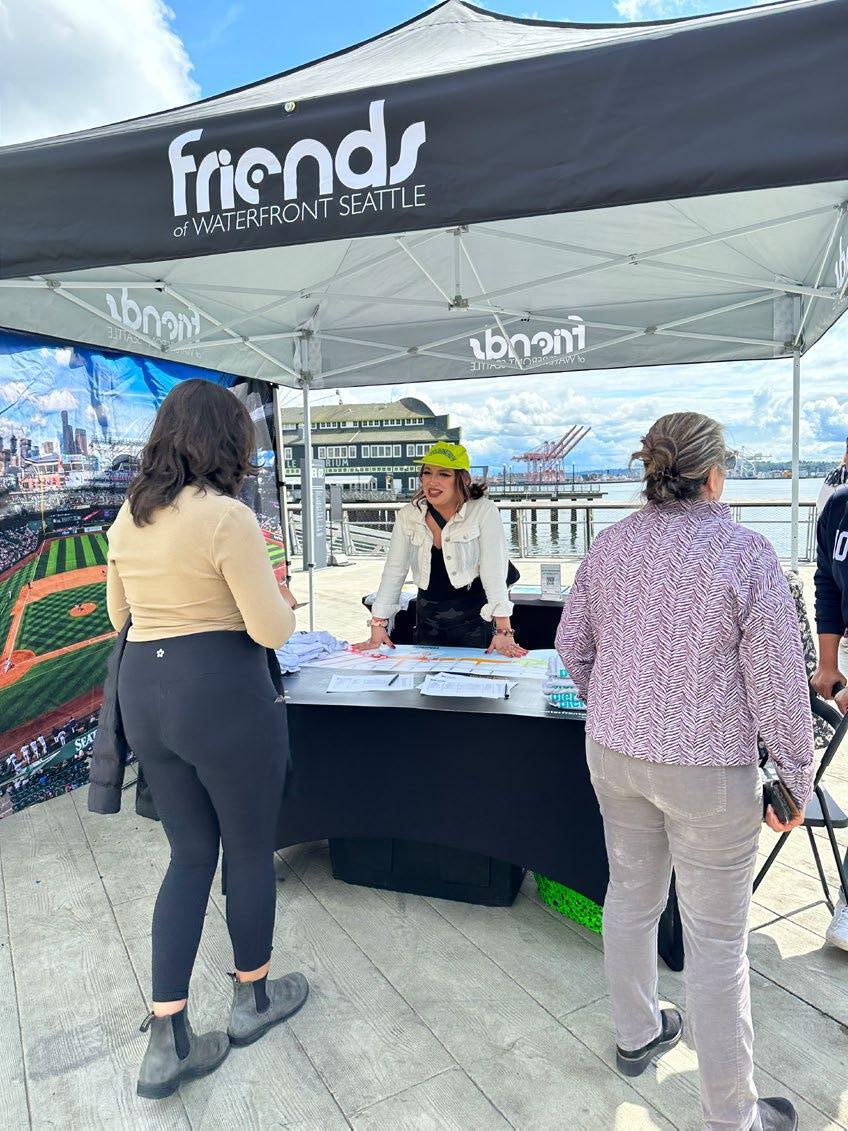


Friends of Waterfront Park Cultural Master Plan 55
PHOTO: ʔALʔAL CAFE ROUND TABLE
PHOTO: GATES FOUNDATION DISCOVERY CENTER ROUND TABLE
PHOTO: PIER 62
PHOTO: FRYE ART MUSEUM ROUND TABLE
PHOTO: WASHINGTON HALL ROUND TABLE


Friends of Waterfront Park Cultural Master Plan 56
This is the Park Seattle Has Been Waiting for and Deserves
By Washington Hall Round Table 9/15/2023
After 12 years, we are finally bringing this place to life.
It is a living sea, with seafood.
Food can be a lens for activation and engaging culture and allowing it manifest.
Port Like an orgasm of street food.
Street food from around the world. Everything from tasting French fries to mangoes with tajin.
We are known for music.
There is almost no where you can go without hearing music.
And the Waterfront will be music in motion, rolling down the street asking me if I am ready for it.
Next to the silence of no cars.
The waterfront should go from hard surfaces to a softness and lushness.
This is a co-created space that can’t be bought.
To…. Build deep relationships with lots of local people. To highlight the global cultures represented here in Seattle.
The many languages
Fresh clean air and green spaces.
With Benches for the grandparents to watch their Grandchildren enjoying community events
Can it be a place that isn’t dead at 6pm?
Most waterfronts all over the world, is an international exhibition, a mix of locals and tourists.
People will be there because they will receive an invitation, or they will know there is a standing invitation.
“Where do you want to go out tonight? Let’s go to the waterfront.”
It will be a space that is alive with lights, stilt walkers and fire breathers.
A continuation of the sculpture park, that transitions from contemplative space to busy active space.
Make tech part of the family.
Where we grow our participatory culture.
This is a place where people want to contribute.
Port and portal
A little dirty and industrial and not too perfect.
Space that can hold multiple experiences and identities. Grandchildren enjoying community events.
The healing nature of salt water
Most waterfronts all over the world, is an international freak show, a mix of locals and tourists.
If we could capture some of the authenticity that we have
at the …
CID and Pike Place
The sound garden.
Magnuson dog park.
Old Bush Garden
Joe Bar Station Café
T-dock
Space needle
Seward park
Easy street records
Roanoke park
Red apple in CD
El Centro de la Raza
Vera Project
Waterfall park
The Ave
Imperial Lanes
Center house
Golden gardens
Carkeek
Seamonster lounge
The Smith Tower
These places that through magical confluence, and then community emerges.
20 acres surrounding by sea and sound, where we all can leave a part of ourselves behind, for the future.
Friends of Waterfront Park Cultural Master Plan 57
Let’s start a collective dream for our city?
Dream City
By Northwest African American Museum Round Table 9/13/2023
One where you can create belonging and connection. Where we can hold that in Perpetuity?
I feel like I live a city built into a forest.
If you are walking in a park, you will eventually end up back into community.
When you ride your bike along the pathway you smell different food and hear music.
Rush hour bike traffic is actually enjoyable.
The water will attract people who want to move here, people from all over the world. The waterfront should taste like the whole world.
But with places to sit.
I love the smell of the water. We will hear laughter and a multitude of languages. All around the fire pit. There should be drumming circle, an inviting space for music to begin and live.
People will remember going there in the third grade.
We get to see mount Olympic, Public art, Vendors being a representation of the city.
We are still in the City, we are still Downtown, surrounded by sounds.
Diverse communities like colorful kites.
Sketchy magicians and musicians, Solitude and celebration can co-exist.
The price for entry here is free.
How do we create an opportunity for people to come
together despite the weather?
I have some ideas in mind.
It starts with the children and locals.
Get out of the books and get to the waterfront. Incubating new ideas.
The food cart, to the food truck, to the brick and mortar.
Amplify that.
Early communication so people feel cared for.
Be clear you are centering a community, but all are invited.
Being in the surprise.
I kinda love the fall in Seattle, sorry.
It’s where the party is at with a hint of nostalgia.
You can only eat so many fish and chips and get trinkets from the Ye Olde Curiosity Shop
That’s why we need a kid’s walking tour that shows off bits of history
Authenticity is hard to come by. It means it is being used and provided by community. Judkins, Seward park, and Alki.
Bear Sheva, Rainier Playfield, Cal Anderson, Sick’s stadium pre-Lowes, The Station, Pho bac,
7 star women’s Kung Fu, Farmer’s Market, Rollaround Sea-Town, Taking Black Pride, Chinatown-ID, Capitol Hill, Family run restaurants, And Dirty bathrooms
There is not a lot left.
We must understand and attend to the harm that has happened before.
There is something about locals reclaiming this space so we can show off our city.
What do we want this waterfront to be, for us? There should be cultural significance for everyone. We have never been in this moment before.
Friends of Waterfront Park Cultural Master Plan 58
A Hub for Beauty and Positivity
By ʔálʔal Café Round Table 8/23/2023
Diverse, Laughing,
Locals and visitors are welcome.
Frankfurter and fresh waffle cones, Energy exchange, Economic prosperity.
Clean air and sea, Free medicine,
Warm and inviting, Mountains and Water
Not infrastructure over culture.
Can we build a place that feels like it’s “of this place?”
Whose ancestral land is this?
Not what government proclaimed but who does the land remember? Where are we?
We should really know this place?
Consistency & sustainability, Hub for the free community building and arts. We need to prioritize our own people.
The people who wake up to the mountains and the ocean,
Plants grow,
We need to continually feed a place.
Open invitation
It’s going to become our home too.
This was my neighborhood. I got $5.99 teriyaki plate there.
There were gathering places there.
I want my people represented, Not just our artwork.
The visual cultural language of Coast Salish people has been lost. Everyone should know this is Coast Salish territory.
How do we right the wrongs of 150 years?
Sustenance
Food, sovereignty, and place to keep our traditions alive. Medicinal gardens, Natural systems of balance.
The park has to be a living and breathing entity. Land Back.
Friends of Waterfront Park Cultural Master Plan 59
There are Many Important Histories on the Waterfront
By Mithun Round Table
10/6/2023
There are many important histories on the Waterfront.
Including the history, we are creating right now.
Everything should be woven together, community and place.
The park can be canvas for our collective dreams.
We will smell clear air and not smoke
Hear the sounds of nature and music
Experience Good lightning
Hear the ferry whistles
See artists responding to place
Container ships with sails
The Seawall covered with critters and plants
Sealife that isn’t polluted
Amplify the importance of the port’s industry
We will see familiar faces, and the people I grew up with there.
Hear children laughing, different languages
Layer arts in culture into the waterfront like the layers of the mountains.
Human-centered,
Elderly couples walking
Old fisherman laughing
Parents teaching kids how to ride a bike
Teens and young adults, making the space their own.
And way less cars.
Temporal art, murals, and people can come back and see the mark they made on the waterfront.
The future doesn’t have to be worse.
People want to be anchored here.
Nature has its resilience built into it.
Life can return to these waters, and that would be a testament to changing the course of history.
Authenticity is hard to come by, but it looks like;
Pike Place Market, the soul of Seattle
Washington Hall, that sense of history being key
Jimi Hendrix Park
Alki beach, a come as you are location
Seattle Center and the monorail
Gasworks park
Ballard and its working class and fishing history,
It is an example of balancing history and growth
The C-ID, a place that serves their elders
Rainier beach community center
Red apple of beacon hill
Pow wow at discovery park
The Central library has become a home.
Each neighborhood in Seattle, has aspects that makes them true to themselves.
You don’t have to sacrifice who you are in these spaces.
Evolving is an important verb.
Embracing change while not forgetting our hard histories.
We must tell a full story of this place if we want everyone to feel welcome.
We are never going to forget the Indigenous history of this place.
Shift and replace the neo-colonial narrative.
Let’s have an empowering narrative.
The Chinese exclusion act and Japanese internment weren’t even 100 years ago.
Artists and cultural workers are at the heart of the waterfront.
Can the Waterfront be a project that pushes capital into people?
Pay the people who bring the soul power.
Can this be a place where people access Freedom, and that feeling of freedom?
This is your park.
History is storytelling, and the Waterfront is a story that is being re-written every day.
Friends of Waterfront Park Cultural Master Plan 60
What Makes a World Class City?
By Frye Art Museum Round Table 9/22/2023
What makes Seattle a world class city?
It starts with the literal space of the Waterfront and its Openness
Trees blowing and birds chirping
The smell of flowers and dirt
Smells like fried chicken, butter popcorn and kimchi, and sea air
I would like to have tacos
Cultural dishes upon cultural dishes
Savory and spicy
I want to taste celebration
Travel down the path to …
Children playing
Intergenerational groups and family
Melanin everywhere
Local artisans as vendors
Passive art and music to enjoy
Pop-up experiences
Busking- it doesn’t always need to be amplified sound
Bikes and less cars
World-class cities should, on some level, have an attraction to the rest of the world.
We will have physical and emotional safety at all areas of park.
Stand on the overlook walk, and see
A place youth have to belong.
Activations from dusk to dawn.
BIG concerts next to space where you can have quiet conversation.
Sea lions
Places to work on our fitness.
Community gardens
Lots of languages
Music and clapping Waves, and wind
The Waterfront should be like...
The Station Coffee shop, everyone knows your name.
Wa Na Wari, for the same reasons. Free and welcome.
Musang, every time I go there, the staff gives me hug.
Randy’s house, a vision of possibility.
It’s weird and awesome that people come from all over the world to watch people throw fish at each other.
Langston
Seward
Judkins
Alki Beach
Corner of Pike and 10th, slice of old City
Places that retain their essence
Madaraka festival
Fremont troll and the Fremont weird
Pike place market and the people who live and work there
Authentic space is not scalable
Snoqualmie Falls and storytelling and history keeping
A space that is cared for and not exclusive
There is a way in which these places and people let us know we belong. Keep this.
I want to feel the warm of the sun and the salt of the sea.
And the warm of people being gathered together. A play to stay dry.
If you want to be world class,
You have to have multi-lingual signage.
Figure out the rules, to explore possibility. Keep the governance local.
Provide support and help community navigate systems to make the magic happen.
You should highlight what’s great in all your neighborhoods on the waterfront.
Amplifying Seattle’s culture through a value’s lens.
A world-class city should be able to construct, deconstruct, reconstruct while keeping its identity
A place where anyone can show up and do something. Community taking up space in the way they wish to.
Friends of Waterfront Park Cultural Master Plan 61
We Are Building a Road Map
By Gates Foundation Discovery Center Round Table 9/20/2023
We are building a road map.
And we aren’t actually done yet.
Anything is still possibility.
North
This is prime real estate, so we know we need to be intentional about how we bring people into this space.
The smells of the seasons. Chocolate, cinnamon and chanterelles
We can help so many communities with fun.
Iconic art to make it destination.
Where you can get right up to the water and touch it.
Barbecue there.
I think of the waterfront as a tourist trap, so to change that would be so amazing.
Seeing dance and storytelling from every community.
I have to say I loved how we all connected with each other’s ideas.
Accessibility and affordability.
Go South and East
The first Latin restaurant in Seattle was on the waterfront.
Authenticity looks like….
White center- its so community based
Blue collar roots of Seattle have been taken for gratitude
Hat and boots park
Arboretum
West
Imagining what we want to feel. We want to feel the whole spectrum of human emotions. Can this be an every feeling place?
I am always thinking about a village concept. I am brewing a dream that can happen there. Rotate organizations throughout the year around culture that can touch many aspects of life. Youth, food, clothing and economy.
Little Vegas. You can be in this whole park and not need anything.
Youth, elderly and the wise.
We are focused on bringing people to the waterfront. That brings us back to food, of course. And activities.
This is Seattle’s amplifier.
Now backwards map these dream into a reality.
Friends of Waterfront Park Cultural Master Plan 62
It is a Journey and a Destination
By Community Connections Committee Round Table
9/6/2023
We Feel…
It must be effortless to go there and be there. The Hand of my friend in a high five
Vibrant a colorful waterfront Culture
Lots of happy people technology
Like a party and a carnival.
Cool seating and railings.
Exercise equipment
Many versions of home Good flooring. Healing
Like the old Seattle Center
Safe and accessible
Areas of rest and play
A place to be alone
Everyone should feel included in what is being created and shared.
Feels warm even when its cold
We Taste…
New foods to try from underrepresent underrepresented communities.
Celebrate heritage months and foods. Indigenous food.
Affordable and delicious.
We hear…
Live music and DJ’s
Kids playing with elders Conversations
Water fountain, with music like Vegas Laughter
Elliott way can be sensory pollution, we want clean air and ocean smell
People and music not overpowered by hustle and bustle.
Different colors, blue ocean, green tree
History and storytelling
We smell…
Smells like cultured food.
Smells like clean bathrooms
We need…
Places to check out boats, bikes and equipment Pedicabs
A place that locals go and tourists
A balance of nature and city Transportation shuttles
Bring the streetcar!
Tables with and without umbrellas
To Highlight different neighborhoods
We have…
All kinds of life,
Plants, animals, and all kinds of humans.
A place that gives as much as it receives.
We See...
A place that looks like a pre-colonial history, without the trauma and harm.
Community Murals
Natural and clean trees and birds.
Lots of ferries and boats
Bring the maritime back
Can we have little paintings on the road signs?
Ongoing interactive artwork, that include audio
Signage and wayfinding
Direct people down to the water.
Statues and sculpture
Shared ownership
A illuminated marquee that says “Welcome to Seattle.”
All roads lead to the Waterfront, getting here, being here, is part of the beauty of living here.
Friends of Waterfront Park Cultural Master Plan 63
Community Co-Design

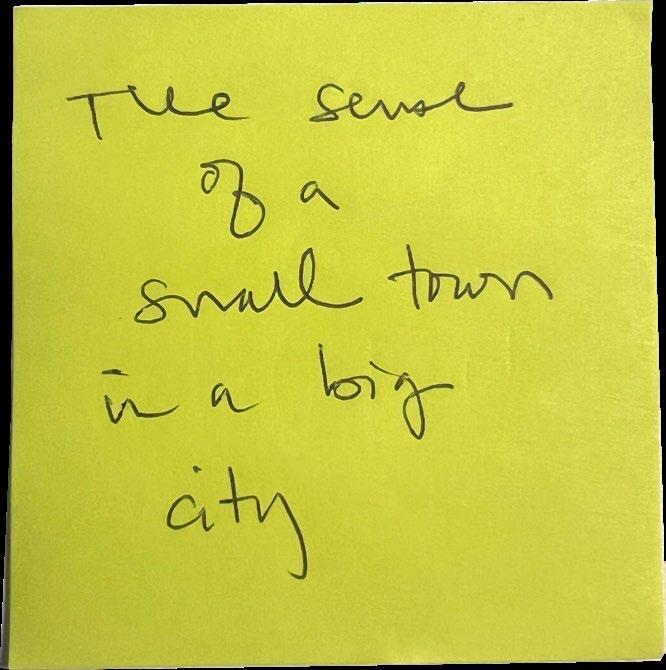

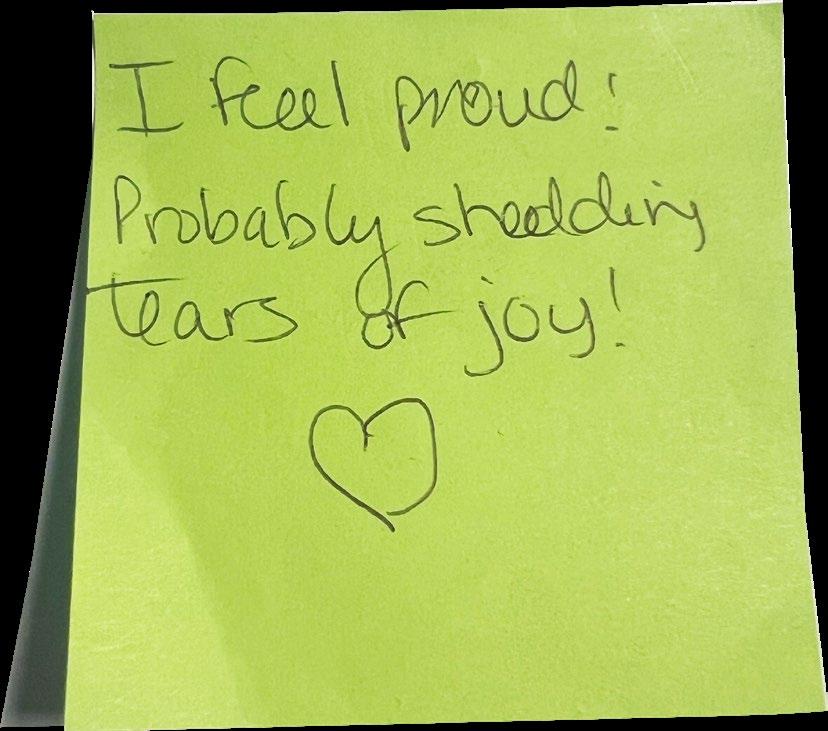

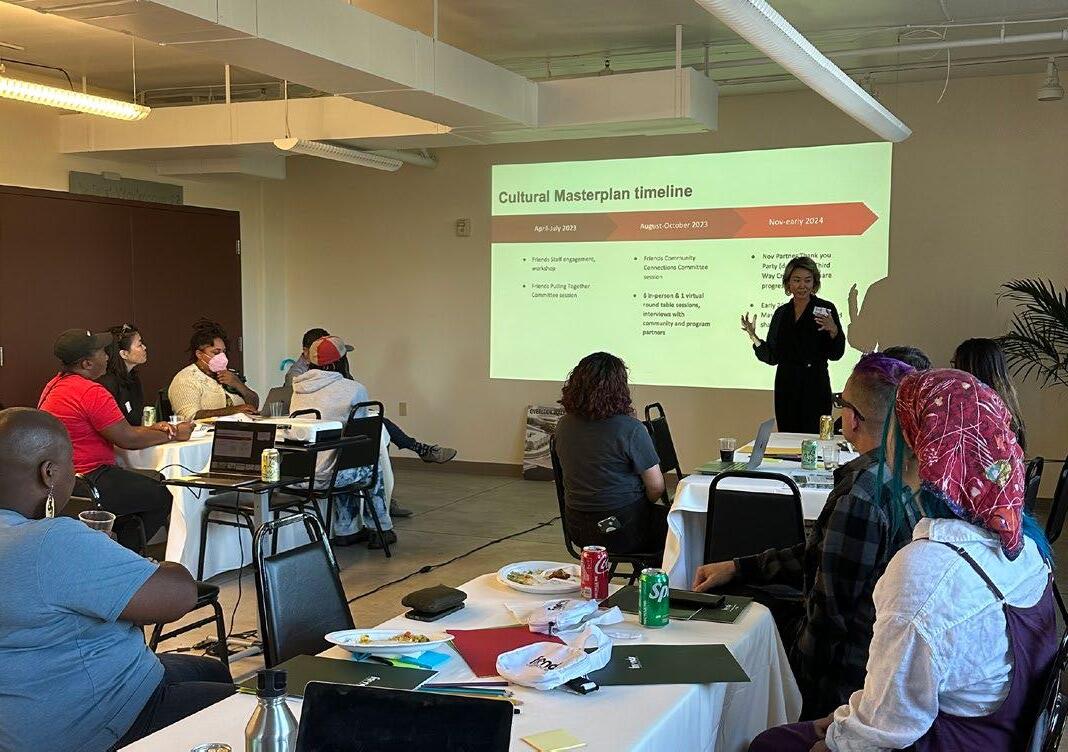

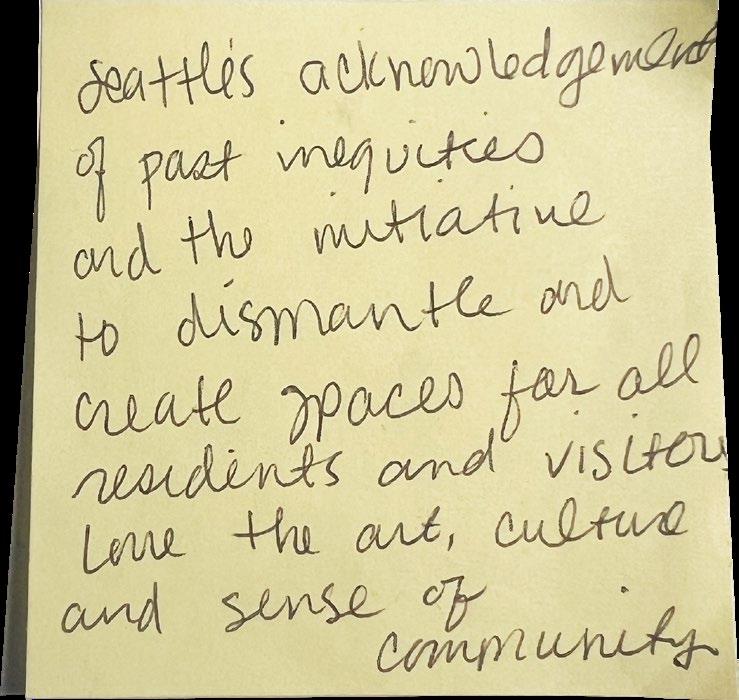



Friends of Waterfront Park Cultural Master Plan 64
PHOTO: PIER 62
PHOTO: PIER 62
PHOTO: MITHUN ROUND TABLE
PHOTO: NAAM ROUND TABLE
Credits
Thank you to everyone who contributed to the development of this plan.
Friends of Waterfront Park
Amanda Streams
Angela Escudero
Anna O’Donnell
Antinee Phongvichit Eteaki
Brianna Browne
Cody Purchase
Denise Evans
Dillon Prevo
Eldon Tam
Erika Chen
Jamala Myres
Jason Merges
Jessica Lotz
Jordan Remington
Joseph Smith
Joy Shigaki
Kelli Faryar
Kelsey Oliver-Connelly
Kjerstin Laine
Laura Hendrichsen
Maria Lopez
Maria Reyna
Mark Meuter
Nico Onoda-McGuire
Oona Kilcommons
Priyanka Anand
Richelle Dickerson
Shiva Shafii
Thomas Beck
Yoon Kang-O’Higgins
Community Conversation
Attendees
Aaron Clark
Akemi Boyd
Jessica LaTour
Kim Deriama
Leila Perez
Louie Gong
Nick Christian
Ronnie Mason
Susan Balbas
Tierra Taylor
Chevon Powell
Fabienne Beard-Wright
Tarik Abdullah
Domonique Juleon
Rosa Garcia
Andrew Constantino
Hailey Hunt
Sam Dick
Ruri Yampolsky
Kitty Wu
Andy Fife
Chris Woodward
Eduardo Rojas
Seth Geiser
Charlotte Beall
King Khazm
Joshua Curtis
Kiera Lyssikatos
Theresa Kouo
Heaven Quiban
Sinae Joy Cheh
Brianna Klein
Misa Pang
Deborah Sepulveda
Afua Kouyate
Matt Hooks
Joneil Sampana
Mansa Musa
Barbara RodriguezGonzalez
Ethan Raup
Meli Bless
Miranda Arney
Simon Okelo
Deane Sienega
Cat Tarvin
Deja’Nay Gilliam
Amirah Karim
Heather Ryan
Gülgün Kayim
Bob Donegan
Tom Smith
Jordan Erdahl
Erik Guttridge
Kelsey Donahue
Ebony Arunga
Jody Levin
Savannah Smith
Carol Binder
Calandra Childers
Che Sehyun
Jennifer Ott
Kathy Hsieh
Alex Nason
Kathe Marulanda
Jessica Lynes
Brenda Goldstein-Young
Reese Tanimura
Kim Hodges
Cameron Blair
Gerard Wirz
Michael Beetham
Carina del Rosario
Erika Chen
Avery Barnes
Rosette Royale
Nova Newcomer
Randy Ford
Trevor Dykstra
Atlee Treasure
Adra Davis
Darcie Larson
David Glenn
Frank Kwang Woo Nam
Ronan Kang-O’Higgins
Blessing Beam
Mae Dela Cruz
Rey Rosario
Maxene Orejudos
Ciera Leciel
Ev Randles
Community
Connections
Committee
Sarneshea Evans
Taelore Rhoden
Tracey Wong
Margo Jones
Rosendo Ayala
Eze Oluo
Amy Cheng
Priya Frank
Jaykub Rafael
Victor Loo Pulling Together
Committee
Melanie Montgomery
Jordan Remington
Jessica Juarez-Wagner
Ellany Kayce
Jessica Hernandez
Kerri Hill
Edna Wyena
Mercedes Luna
Mark Colson
Gina Corpuz
Ixtli White Hawk
Tim Reynon
Friends of Waterfront Park Cultural Master Plan 65
Credits
Thank you to everyone who contributed to the development of this plan.
Production, Development, and Co-Facilitation
Randy Engstrom
Third Way Creative
Co-Facilitation and Poem Synthesis
Elisheba Johnson
Facilitation Co-Design
Hollis Wong-Wear
Design
Jeff Lawrence
Pretty Pretty Good
Narrative and Editorial Development
Leah Baltus
Leadership and Coordination
Yoon Kang-O’Higgins
Maria Reyna
Nico Onoda-McGuire
Friends of Waterfront Park

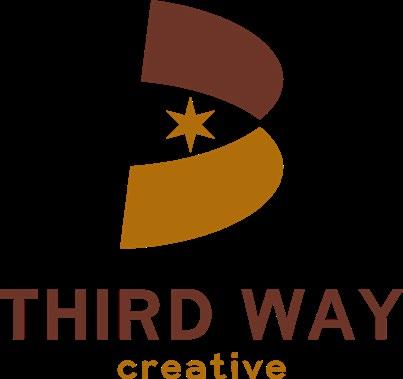
Friends of Waterfront Park Cultural Master Plan 66
Thank You.

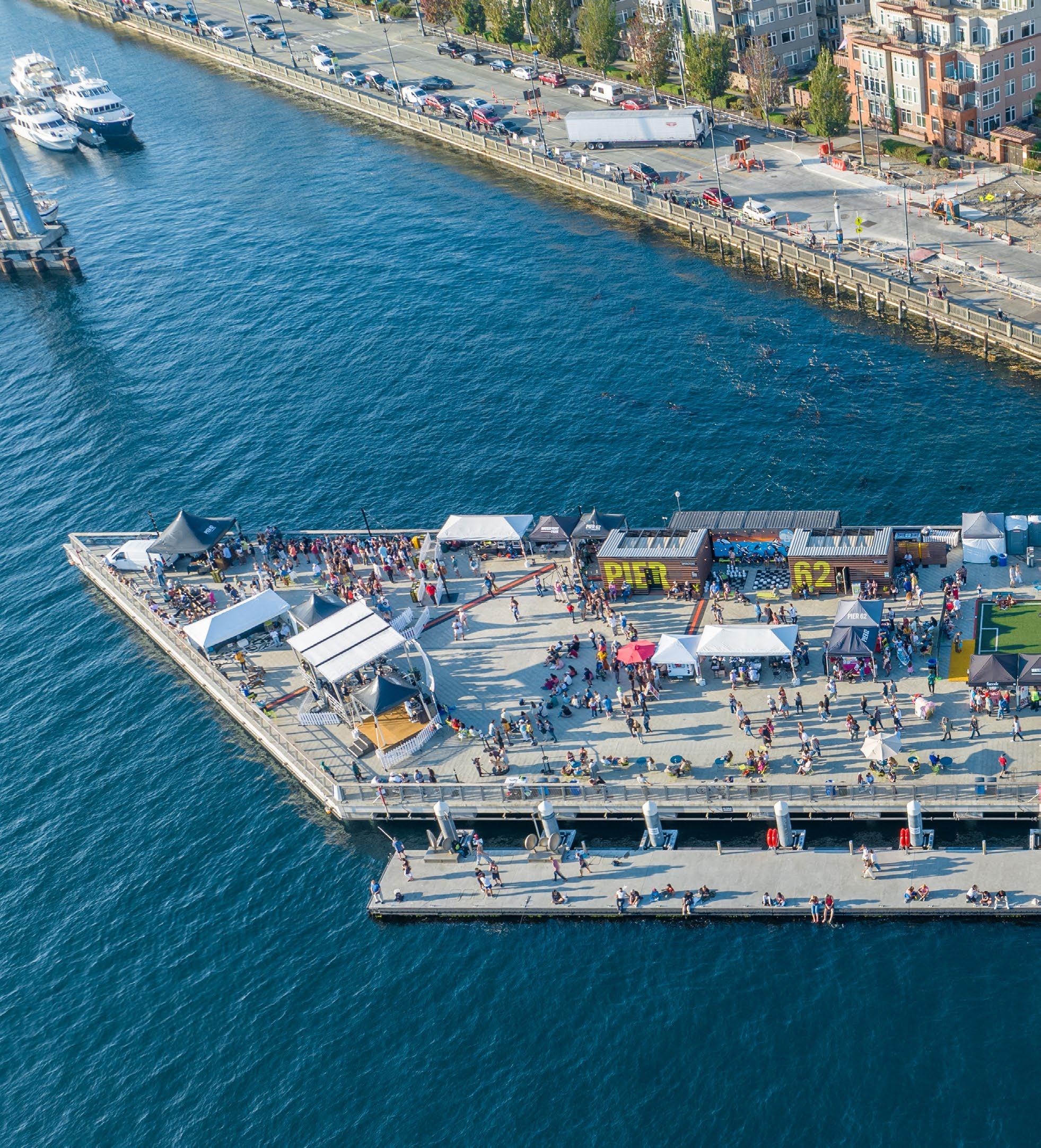 PHOTO: ERIK HOLSATHER, WATERFRONT BLOCK PARTY, 2023
PHOTO: ERIK HOLSATHER, WATERFRONT BLOCK PARTY, 2023
 PHOTO: ERIK HOLSATHER, WATERFRONT BLOCK PARTY, 2023
PHOTO: ERIK HOLSATHER, WATERFRONT BLOCK PARTY, 2023





 Joy Shigaki President and CEO Friends of Waterfront Seattle
Joy Shigaki President and CEO Friends of Waterfront Seattle










































































 PHOTO: ERIK HOLSATHER, WATERFRONT BLOCK PARTY, 2023
PHOTO: ERIK HOLSATHER, WATERFRONT BLOCK PARTY, 2023